Celebrating Pride
Happy Pride Month! We proudly donated to the Trevor Project and GLAAD to reinforce our commitment and allyship to the LGBTQIA+ community. It’s important to us to celebrate pride year round by creating a welcoming and inclusive environment and culture. Today, we’re highlighting and amplifying two of the LGBTQIA+ voices of our employees by sharing their stories and recognizing their unique contributions.

How long does it take to truly be considered a San Franciscan? Mark Elkins, Karbo Com’s Head of Human Resources and Operations, has been living here for 23 years and is proud to call the city his home. From his perspective, San Francisco has always been the beacon of what life should be: accepting and supportive. Mark’s story began with a TV show called “Tales of The City”. At the age of 16, Mark watched the show, connected well with what he saw, and was inspired to move to San Francisco one day. Around this time, Mark came out; first to friends at 16, next his extended family at 18, and then to his parents at 21. Growing up in Salem, Oregon, a fairly rural and conservative community, Mark knew he wanted to move somewhere where he felt more welcomed and accepted. While attending college in Oregon, Mark witnessed first hand hate and discrimination from organizations such as the Oregon Citizen’s Alliance. Witnessing these hateful groups prosper helped propel Mark to find his voice as an advocate with the community. Every year, Mark donates to LGBTQIA+ organizations such as the Human Rights Campaign, GLAAD, and Lyric. He also marches for equality, does volunteer work, and socializes within the community, which he truly enjoys.
Mark is grateful to have found an accepting, caring, and conscientious environment and Karbo Com. It is exactly the type of place he wanted to work for, in large part due to the fact that here, in his words “being gay is no big deal”. This sentiment is echoed from the CEO and Founder all the way across the spectrum to every member of the staff. Outside of Karbo Com though, Mark describes the biggest threat to the LGBTQIA+ community as the lack of true equality that is recognized on a federal level. “If you can be fired from your job, prevented from voting, or evicted from your home for being gay, there’s still so much more left to do”. Additionally, more recent reversals of Obama-era policies and a surging homophobic sentiment in parts of the country have made it clear that for many there is still a lot more work to be done, and the fight for equality is far from over.
For Mark, Pride Month isn’t just a time to celebrate, but should also be a time for political activism.”Things are not where they should be and have a long way to go. It’s time not only to be aware but to take action”.

Lately, you may have been hearing about preferred pronouns: whether it’s seeing them on social media, in email signatures, or it comes up in conversation. Karbo Com’s Creative Director, Courtney Stack, has led the charge when it comes to having open dialogues and discussions on this subject matter. Besides her work at Karbo Com, Courtney is also a multidisciplinary artist, working across painting, photography, sculpture, movement, and writing. Courtney’s pronouns are she/they. Courtney joined Karbo Com in 2019 to launch the agency’s in-house Content Studio, critically expanding service offerings to encompass visual branding, full service social media, photography and video, writing, and more. I asked her to share with me why pronouns are so important on the most personal level.
“I believe that gender is a spectrum. Gender norms conflate anatomy with gender identity, collapsing that spectrum into a limited, prescriptive binary (male, female). The gender binary doesn’t acknowledge human experiences and identities that fall between or outside of those accepted norms. When we limit our understanding of gender identity to the gender binary, we limit our understanding of each other, and of ourselves. When we share our pronouns, we are claiming an opportunity to be better known to one another. We are acknowledging that a person’s gender identity is not something that can be assumed based on the way they look. We are signaling that all gender identities are valid. We are creating space for a more inclusive, diverse, authentic, and loving future”. Courtney’s use of “we” clearly illustrates how important and timely these discussions are in terms of continuing to foster and build a truly accepting and kind environment around us.
Especially when we find it challenging to understand, being curious, asking questions, and learning is a good place to start. As Courtney says, “As a gender queer/fluid person, I appreciate being recognized as such. As human beings, we understand ourselves, in part, through external affirmation. When my internal identity is seen, affirmed, and accepted by others, I feel that I can be myself and lead a more authentic and fulfilling external life. Pronouns play a role in all of that”. There are many pronouns out there. Most of us are familiar with she/her and he/him pronouns. Gender identity terms also include gender neutral pronouns such as they/them, xe/xem, ze/zim, and sie/hir. There are many great resources like GLAAD and the Anti Defamation League if you’re not sure where to get started and want to learn more.
But, why is this important for companies? Company leaders should encourage employees to share their pronouns as well as respect colleague pronouns to signal acknowledgement and acceptance of all employees, regardless of gender identity. This creates a more inclusive, humane workplace. Best practices so as not to misgender someone are simpler than you might imagine. Courtney put it best, “Don’t assume that you know another person’s gender. Instead, simply ask them. Then use the pronouns that they have told you they identify with when referring to them. “ It’s no biggie. Just ask, “What are your preferred pronouns?” This question is easily posed when meeting someone for the first time, alongside other standard introductory questions like, “What’s your name?” But it’s also a question you can feel comfortable asking of someone you’ve known for a while: “Hey, I realized that we never discussed preferred pronouns. My preferred pronouns are X. What are yours?”
Finally, as we look to the future, there are several examples of actions businesses should take to “walk the talk” and ensure that they are truly prioritizing diversity and inclusion. Businesses can show meaningful, change-making allyship with queer communities by publicly divesting from the corporations and entities that oppress those communities. They can elevate LGBTQIA+ employees to positions of leadership and authority. Businesses can also commit ongoing funds and resources to queer organizations all year round, not just for Pride Month. When businesses are truly committed to supporting queer communities, there are a great number of opportunities for them to effect positive change.
UK Tech Sector Resilience Presents Opportunities for Companies Stateside
A dispatch from Mike King, co-founder of Karbo Com’s UK-based sister agency, Eleven Hundred
By Mike King, co-founder, Eleven Hundred Agency, London
 When the Coronavirus crisis hit, like any business owner, I was deeply concerned about the financial impact it was going to have. I had serious discussions with my business partner, Claire about the emergency steps we could take, should we see a significant drop in revenue. At the top of our priorities was ensuring all our staff would continue to be fully paid for as long as possible.
When the Coronavirus crisis hit, like any business owner, I was deeply concerned about the financial impact it was going to have. I had serious discussions with my business partner, Claire about the emergency steps we could take, should we see a significant drop in revenue. At the top of our priorities was ensuring all our staff would continue to be fully paid for as long as possible.
It turns out that, in spite of the broader economic downturn that followed, our concerns were unfounded. I feel almost guilty writing this, but the opposite of what we feared has actually happened. Since the UK went into lockdown in March, we’ve seen continued growth in revenue and have taken on additional staff.
As a PR agency that specializes in working with technology firms, my feeling is that this says more about the resilience of the UK tech sector than it does about our specific company. And it represents a unique opportunity for tech companies looking to expand to the UK.
Tech Outperforms Wider UK Economy
According to official UK government statistics, GDP fell by a record 20.4% in Q2 2020, the second consecutive quarterly decline following a 2.2% drop in Q1. Admittedly, there are some signs of hope as we come out of lockdown, with GDP growing by 8.7% in June 2020, but there is no doubt that the UK economy has been hit hard.
In the technology sector, it’s a much different picture. In June, the Financial Times published an article looking at companies that have performed well through the pandemic. The list was dominated by large technology companies.
IT spend in the UK is predicted to rise as tech budgets increase. According to CWJob’s annual Confidence Index, 49% of IT decision-makers believe their companies will increase their tech budgets as a result of the Coronavirus outbreak.
At times of rapid change, there is a lot to communicate.
UK Tech Growth Sectors
This growth in UK tech mirrors our own direct experiences. Changes in working practices and the massive increase in the number of people working from home have boosted areas such as cloud computing, cybersecurity, communications, video conferencing, HealthTech and EdTech. In many instances, digital transformation programs that were already underway have been accelerated, with long term implications on the way we live and work beyond the current pandemic.
“We are now very much into what many people are calling the “new normal,” said Steve Leighton, CEO of Voneus, a rural community broadband specialist. “The pandemic has forced people to spend more time in their homes which means they’ve had to work, learn, shop, play and relax without going out. A reliable broadband connection has never been more important and demand for our services has never been greater,”
“Business has remained robust during the Covid-19 crisis,” said Chris Lewis, head of group marketing at Livingstone Group. “We help clients save on average 38% on their major software and cloud contract renewals, avoid substantial penalties from non-compliance fees from software publishers and ensure their software and cloud estates are optimized and clients are only paying for what they actually need. With many organizations now focusing on cost savings because of the financial pressures caused by the pandemic, demand for our services continues to grow and our organization is growing as a result.”
Of course, some areas of the technology sector are suffering. Tech firms that sell to hospitality, leisure and travel sectors, for example, are having to adapt to massively reduced customer demand in the short term with many re-evaluating how they move forward. At Eleven Hundred Agency, we have seen a couple of clients suspend PR activity to reduce expenditure, but this has been more than outweighed by those clients that have increased PR spend to take advantage of market growth. It is true to say that we have never been busier; at times of rapid change, there is a lot to communicate.
“VAR’s are looking for new and exciting technologies to offer their clients in an effort to stimulate their own businesses and we have signed up nine new reseller partners in the past two months,” said Peter Christou, EVP international sales at BotRx, a cybersecurity firm that protects against automated bot attacks.
London has outperformed all other European cities, raising more VC investment than Paris, Stockholm and Berlin combined…
UK Tech Start-Ups Continue to Prosper
According to research published in June this year by Tech Nation and Dealroom.co, many UK tech startups have continued to attract investment, recruit staff and see positive growth. London has outperformed all other European cities, raising more VC investment than Paris, Stockholm and Berlin combined so far in 2020, with Fintech and enterprise software the two largest areas for investment.
The UK Government is keen to stimulate this area by supporting start-ups in the UK tech industry. In May, it opened its Future Fund for applications, providing £250m in loans to support growth and innovation in sectors such as technology, life sciences and the creative industries.
US Companies Looking to the UK
There are opportunities in the UK for U.S. technology firms that are operating in growth areas, but in the current climate, they need to tread carefully. The big difference now is the pace at which we are seeing change. Here’s my checklist of critical steps that need to be taken to increase the chances of success:
- Undertake thorough UK research to understand the true size of the opportunity that exists (or doesn’t).
- Carefully consider local market conditions. Often these will be similar to the U.S., but with some important local differences, e.g., local competitors, channel set up, regulatory environment, etc.
- Ensure the right people are recruited with the experience and skills to fully understand the UK business environment you want to operate in.
- Fund the venture properly and provide ongoing support for UK operations from headquarters.
- Most importantly, be flexible and nimble. If Coronavirus has taught us anything it is the importance of being able to quickly adapt to changing conditions.
Following these essential steps, U.S. tech companies will be well-poised to capitalize on the continued growth of the UK tech sector.

Mike King, Co-founder Eleven Hundred Agency, London
Mike has more than 25 years’ experience of running PR agencies in the technology sector. He has worked with clients ranging from global tech brands through to innovative, fast-growth start-ups, and has helped many US-headquartered companies expand and grow in the European market. Originally a technology journalist, Mike ran the London office of a small European PR group for several years before founding his own tech PR agency, Johnson King, in 1992. Johnson King grew to become one of the leading European tech specialist PR firms and, in 2014, was acquired by a large global agency. After completing an earn-out, Mike co-founded Eleven Hundred Agency with Claire Ayles in 2018.
Zeguro CEO On How To Overcome Cybersecurity Marketing Challenges

Zeguro’s CEO and co-founder Sidd Gavirneni, and Digital Marketing Manager Ellen Zhang
Since the start of the COVID-19 pandemic and the transition to remote work, the number of reported cyber attacks has skyrocketed, highlighting the critical need for greater cybersecurity adoption. The growth of the cybersecurity industry has soared over the last couple of years with digital transformation, regulatory compliance, increased security threats due to COVID-19, and response capabilities all playing a role, according to a recent Gartner report. Global information security and risk management end-user spending is now forecasted to reach $174.5 billion in 2022.
While the industry is booming, countless cybersecurity companies are jockeying for a piece of that business. It’s becoming increasingly difficult for cybersecurity companies to differentiate themselves in a saturated market, and for many, breaking through means overcoming critical marketing challenges around brand awareness, market education, and building trust.
To learn more about how cybersecurity companies are overcoming these challenges, Karbo Communications spoke to Zeguro’s CEO and co-founder Sidd Gavirneni, and Digital Marketing Manager Ellen Zhang. In a crowded market, Zeguro is managing to stand out. By integrating cybersecurity and cyber insurance, Zeguro is creating a new product category and finding a foothold with small and medium sized businesses. In our virtual “In the Know” discussion, Sidd and Ellen shared Zeguro’s strategies for building trust, educating target audiences, and gaining traction in the saturated cybersecurity market.
Tell us a little bit about what inspired you to start Zeguro and how you identified a need in the market for integrated cybersecurity solutions and insurance?
Sidd: I’ve been in cybersecurity for over 20 years. Prior to Zeguro, I was managing Polycom’s product portfolio and served on their information security board when they experienced a data breach. Typical phishing attack, you know, someone asking the HR person to send out employee data and he does. During the aftermath of that breach, I came to learn that dealing with cyber insurance can be a really painful process.
Around the same time, my Zeguro co-founder, Dan Smith, was in the process of renewing cyber insurance for the bank he was working for. It was a nightmare. The whole process was broken and it took him about three months just to renew. Also happening at this time, a friend of mine, who runs a clinic in Houston, experienced a data breach—another phishing attack. The small business need for better cybersecurity insurance was quickly coming into focus. So Dan and I co-founded Zeguro in 2016 to address this clear market need and to help small businesses.
As an insurtech startup, what are a few ways you are positioning Zeguro as a better alternative to the more established and traditional insurance companies?
Sidd: Traditional insurance is sold through brokers. If a small business wants to get a cyber insurance policy, they go to a broker and have to fill out a two or three-page paper questionnaire. Then the broker sends the questionnaire to the insurer, and the insurer either approves or rejects them. If the insurer approves them, the broker sends a quote to the customer, who can then purchase the policy. This whole inefficient process can take up to a week or more.
With the Zeguro platform, everything is digital and easy for the small business. They can get a quote and purchase their policy in less than five minutes. This is one way Zeguro is bringing insurance into the digital age.
And then the other piece is making insurance easy to understand for these businesses. If you look at our messaging, our website, and everything within the customer’s purview, you’ll see that we take great care to make all of the insurance legalese digestible and that we’re always clearly addressing the pain points of our customers. The same thing goes for security.
Our approach of making cybersecurity and insurance easy and integrated is what makes us different from any other insurance company.
According to experts, cybersecurity is the fastest-evolving threat landscape insurers must deal with. Cyber attacks get more sophisticated and less predictable every day. While traditional insurance companies may struggle to keep pace, Zeguro appears uniquely positioned to succeed because of its integrated model.
Can you elaborate on your key differentiators?
Sidd: Historically, cyber insurance companies have had a problem with data: no insurance company has enough data to create accurate pricing and better serve the customer by providing a tailored cyber insurance product.
That’s where Zeguro comes into play. Our approach of integrating cybersecurity with cyber insurance helps us better underwrite and provide tailored cyber insurance to our SMB customers in a way that our competitors can’t. Our approach to cyber risk management is uniquely holistic. Zeguro makes it easy for small businesses to understand cybersecurity by making it approachable and telling them exactly what they need to do to also save on their insurance. Zeguro customers who buy our insurance get the security platform for free. And customers who buy our security platform get insurance at a lower premium cost because their risks are lower. It’s this integrated approach that makes Zeguro unique.
You have an extensive background in strategic management and product portfolio management working at companies like Polycom and Accept Corporation. How has your previous professional experience influenced Zeguro and its integrated business model?
Sidd: It’s a combination of our team’s professional experiences and personal experiences that have influenced Zeguro to be who we are today. Personally, I grew up in India, moved to the US to Kansas, got my MBA in Spain, and now I’m here in the Bay Area.
I was a software engineer by profession. So, my education centered around computer science and cybersecurity. I worked as a software engineer at a telecom company, and after a few years of that, I was ready to move towards more of the strategic aspects of business.
My MBA was very much focused on entrepreneurship, and after my program, I started working more on business strategy and the product portfolio. It’s a combination of all of these experiences that have helped me to get to where I am today, and it’s our diverse, collective experiences as a team that have also helped us shape Zeguro.
We would love to hear more about diversity at Zeguro. How does diversity contribute to Zeguro’s success?
Sidd: Customer satisfaction is central to Zeguro’s branding and identity. The only way the customer can be fully happy is when we best understand their needs and are able to empathize with them and help them achieve their goals. That’s one thing we have done very well. We have brought in that empathy, which we think is a direct result of our diverse team.
As a team of 12, we have seven countries represented, males, females, LGBTQ, and people of all ages. Having a diverse team helps us work better with each other, but also creates team empathy which eventually flows to our customers. This combination of different views and perspectives is what gets us to keeping our customers happy and satisfied. Through that, we have had quite a few referrals and partnerships develop. Diversity plays a big role in who we are as a company.
How does Zeguro successfully attract such a diverse talent pool?
Sidd: We have a set of core values, and it’s those values we look for in a person versus just finding someone that fits into our culture. We believe that culture should evolve over time and everyone coming in helps shape the culture. So it’s more about those core values, and one of them is diversity. All of these values help us attract folks that believe in diversity. One thing that we do is use talent sourcing tools where we can hide the name and picture of the person and be neutral about things like looks and names.
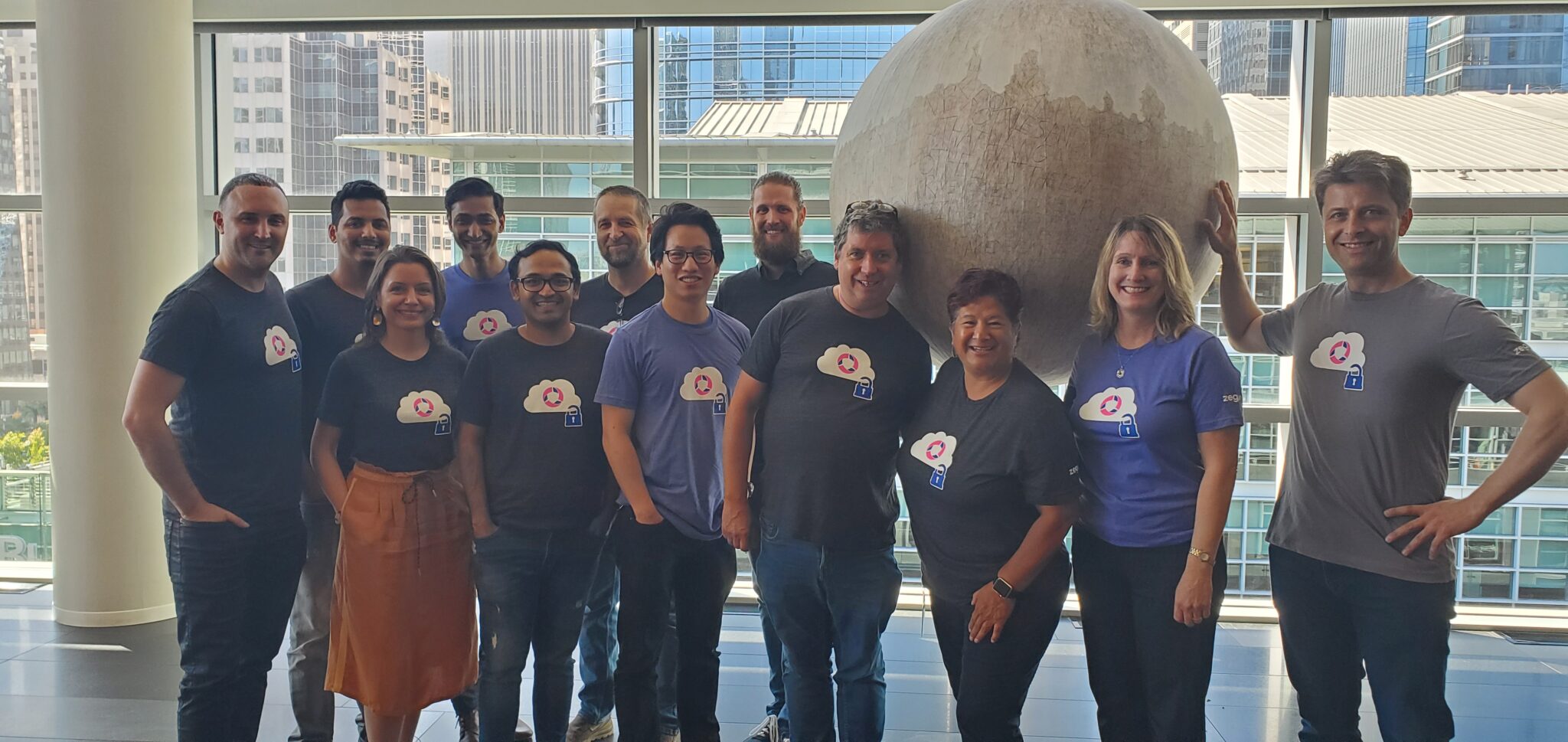
Zeguro’s diverse team features members from seven different countries and various backgrounds.
What are a few of the biggest marketing challenges you face as a cybersecurity company and what strategies are you successfully employing to overcome them?
Sidd: I think the primary challenge, especially with cybersecurity in the SMB space, is awareness and education. Most small businesses don’t know what to do about cybersecurity. Everyone knows that they should be worried, but they have absolutely no idea what to do. And as a result, they just tend to ignore it. One of the biggest challenges that we face is how do we raise awareness without scaring people away from taking action?
Ellen: The other challenge is that we’re creating and defining a new product category by integrating insurance and cybersecurity. It’s not something that people know to search for on Google yet. How do we target the direct consumer? One strategy we’re testing out right now is partner marketing and growing our partnership program.
Sidd: For small businesses, it really comes down to who they know and what they trust. Our partners are already trusted advisors to smaller businesses, and they can be influential. So it’s really the influencer model that we believe will make a big difference in the cybersecurity and cyber insurance space for these SMBs.
As Zeguro leverages partnerships to build trust and recognition with its target market, what co-marketing strategies are proving to be most successful?
Sidd: Zeguro provides full support to every partner that we work with by collaborating on co-branded materials from marketing collateral to webinars to email campaigns. We also have found a lot of mutual benefit in partnering with other security companies to create material that applies to both their customers and our customers in the security space.
Beyond partner marketing, what marketing tactics have proven to be most successful in connecting with that target customer? How has Zeguro tailored its approach to speak to them directly?
Ellen: On the cyber insurance side, using Google AdWords and paid search have been a really good way to get consistent leads. We’ve been doing pretty well and getting leads at a cheaper cost per lead than the market average for insurance. I think it’s been particularly successful for SMBs because they normally don’t have a dedicated risk manager who can work with different insurance firms and brokers to find cyber insurance solutions. So these people would be googling “cyber insurance coverage” and looking for solutions via Google. That’s been a good way for us to get in front of people.
Narrowing customer focus is one of the top marketing challenges cybersecurity companies face. How did Zeguro narrow in on small to midsize companies?
Sidd: The SMB space is extremely underserved when it comes to both cybersecurity and cyber insurance. While more than 60% of large enterprises have cyber insurance, less than 10% of small businesses have it. And yet, 69% of small businesses had a cyber breach in 2019 — that’s a huge number. Small businesses just don’t have the right tools. The security space is extremely fragmented, and most of those tools are geared towards large enterprises, not the SMB space.
Of course, talking to customers is the number one thing you can do to better understand their unique needs, but we also look at statistics and reports from organizations like the Small Business Administration. We take into account published information about the kinds of risks small businesses face, or FBI reporting on cybersecurity and breaches. We also take into account reports from companies like Symantec, which does a great job on their annual reports on the state of cybersecurity. All of these resources help us better understand and define who within the SMB space we should be targeting.
To add to that, cybersecurity has different kinds of adopters. Early adopters are typically tech companies, because they often have a better understanding of cybersecurity even if they don’t have the expertise in-house. So we’re also looking at what the low hanging fruit is and where we don’t have to spend too much effort on awareness versus the other categories.
For a small business with little to no experience on navigating the complexities of cybersecurity, getting started can be a daunting task. How is Zeguro best positioned to help small businesses start inaugural cybersecurity programs, and how do you incorporate that expertise into your messaging?
Sidd: Businesses expect the same level of functionality and user friendliness from their vendors that they get from their personal apps and tools that they use in their day-to-day life. And that is one way that we make cybersecurity easy for these businesses; it’s all about that user experience of our platform on the security side. We try our best to not make it feel overwhelming for a business owner who has no tech experience to be able to get started with cybersecurity. We provide everything that the business needs to get started within the platform that they would otherwise have to get from a security consultant, who would charge them around $10,000 a year. In comparison, our Cyber Safety solution is as little as $59 a month.
Ellen: We position Zeguro as accessible, as you can tell by the language we use throughout our website and platform. The language is not very heavy on cybersecurity terms, as you would see for enterprise solutions that are speaking to dedicated IT or security teams. We’re really tailoring our message towards people who don’t necessarily understand much about cybersecurity or who are beginning their journey into building a cybersecurity program.
And we focus on providing educational content on our landing pages. For example, on our cybersecurity overview page, we have statistics around the percentage of SMBs that experienced a data breach, how much an average data breach costs, and particular solutions. We explain why they should care about employee security training when the majority of businesses experience some type of phishing or social engineering attack. We focus our messaging on both the why and the how, but simplify it down so it’s easy to understand.
Sidd: Visual branding also plays an important role in this. Our brand colors — pink, purple, and navy — also make Zeguro fun and accessible, rather than the traditional, corporate-looking dark blue that every security or insurance company uses.
I don’t think that there’s any specific area that requires the most education. Every company and every person has a different idea and knowledge level when it comes to cybersecurity, so it’s really about addressing multiple aspects.
On the Zeguro resource page you have a consistent cadence of educational blog posts, ebooks, and guides. It’s clear that providing educational resources is a key component of your marketing strategy.
What are the top education hurdles Zeguro faces and what tactics are your teams employing to overcome them?
Sidd: I don’t think that there’s any specific area that requires the most education. Every company and every person has a different idea and knowledge level when it comes to cybersecurity, so it’s really about addressing multiple aspects. Because as I was mentioning earlier, cybersecurity is about taking a holistic approach that addresses people, processes, and technology. Ignoring even a small piece of any of these three aspects can cause a breach. In our educational material, we make sure to focus on all three components.
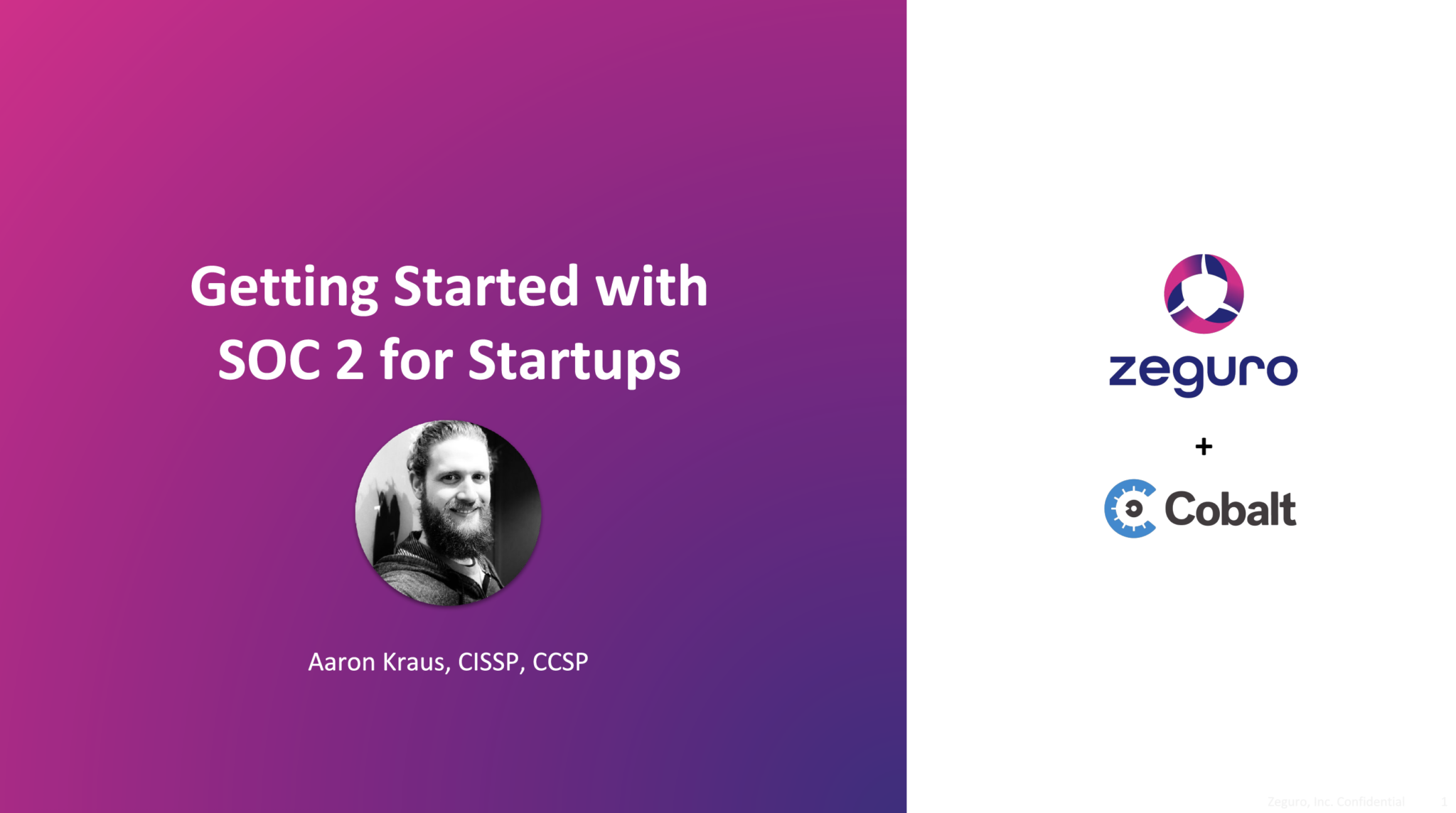
Webinars are a key component to Zeguro’s greater marketing strategy.
Zeguro recently hosted a webinar with infosec expert Aaron Kraus on how startups can initiate an SOC 2 report. How effective are you finding these webinars at improving the existing customer experience or earning new business?
Ellen: We’re really just starting on our webinar program, and as we pioneer this new channel for Zeguro, we’ll look to do joint webinars with each of the partners that we sign on. For example, one of our partners is Graphus, a company that helps protect against phishing attacks, so this fall, we are planning on doing a webinar around identifying phishing attacks and preventing them. And so they’re going to talk about their technology and how they can stop phishing attacks from the email perspective, and we’ll discuss how we can better train employees to recognize phishing attacks, and be more cyber-aware.
Sidd: I think these joint webinars will be important for us because there’s no one solution that can solve all the cybersecurity issues or problems. It will have to be multiple companies coming together in the ecosystem to fix the problems that these businesses face. So for us webinars with our partners is what will be the most fruitful.
As a security and an insurance company, the primary criteria that our customers look for is trustworthiness, and PR has helped us create that level of trust among our customers and partners.
What role does PR play in helping Zeguro meet its business objectives?
Sidd: As a security and an insurance company, the primary criteria that our customers look for is trustworthiness, and PR has helped us create that level of trust among our customers and partners. This is accomplished in large part through media coverage and articles related to our product launches, our partnerships with some of the world’s leading insurance companies, and recognition of Zeguro’s award wins. PR plays an essential role.
Late last month you published a report on the state of B2B SaaS cybersecurity, which notably highlighted that almost 84% percent of B2B SaaS companies have allocated budget to cybersecurity infrastructure in 2020.
How do these reports support your marketing efforts, and how are you tracking ROI?
Ellen: We work with an SEO agency and a lot of our early efforts are focused on content marketing and research for the content. Part of the content mix are these big rock assets, like reports with original data. It’s about establishing thought leadership.
The decision to focus this report on B2B SaaS was strategic. Many of Zeguro’s early customers were young SaaS companies, so we figured that would be a good target market as they typically have a better understanding of technology and require a little less education than some of the mom and pop SMB shops.
Tracking ROI for our content marketing is really about our brand awareness. Are we moving up in organic search rankings? Is our organic search traffic growing month to month, year over year? And are we getting more impressions and clicks for the keywords that we care about?
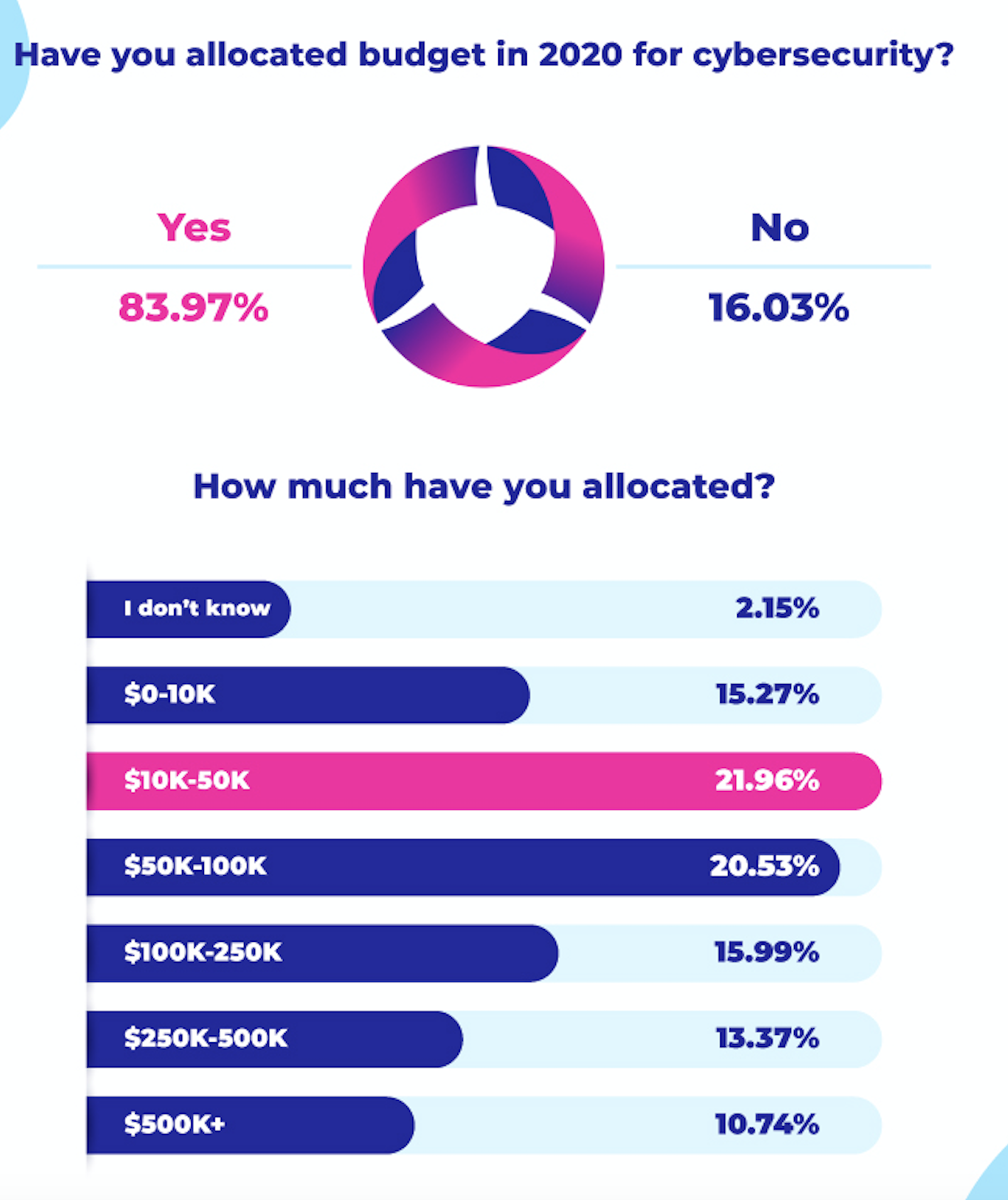
Reports like Zeguro’s “State of B2B SaaS cybersecurity” provide customers with much needed educational materials and strengthen relationships.
Have you been finding these reports to be an effective method for boosting Zeguro’s rankings?
Ellen: It’s a little too early to tell with this latest report, because we only just published it. But towards the beginning of the pandemic, we published a blog post with free security training resources for SMBs. And since that’s been published, it’s consistently been a top performer for our website and for organic traffic as people are searching for training resources. Especially now since everybody’s working remotely and it’s important to educate your employees.
COVID-19 has completely shifted the corporate landscape as many companies have pivoted to indefinite work from home systems. We’ve observed a dramatic surge and increased sophistication of cyber attacks amid COVID-19.
How has this shift influenced the way Zeguro positions itself to prospective and existing clients?
Sidd: We did not change the way that we talked about ourselves. However, the pandemic and increase in cyber attacks have only highlighted the need for a product like ours. So we started seeing that customers and potential customers started resonating more with the messaging that we already had. COVID acted as a catalyst for us.
Can you talk a little bit more about how COVID-19 has affected Zeguro’s business?
Sidd: Because of COVID, content has been performing very well for us. With very few marketing dollars, we are getting more paying customers and that’s a direct result of all of our content efforts over the last few months within the context of the current climate.
What’s on the horizon for Zeguro and the cybersecurity industry as we move into the second half of 2020?
Sidd: The industry itself will keep soaring, there’s no stopping that. Thanks to the upcoming elections, people are even more concerned and there will be even more cyber attacks. We anticipate gaining a lot more traction over the next few months as we focus more on our channels and partners. That’s where we see the industry shifting as SMBs rely more and more on tools and products that provide multiple things in one place.
Ellen: The biggest thing for Zeguro will be growing our partnership program. I’ll be working with Sidd and Dan on account-based tactics to target potential partners and get them onboard so we can grow that marketplace.
This interview has been edited and condensed for clarity
Want more “In The Know” expert insights? Learn how should companies approach growth to achieve results during times of challenge in Karbo Com’s interview with Jonathan Sadow, Co-Founder and Chief Growth Officer at Scoop Technologies.
7 Tips For Creating An Award-Winning Case Study Video
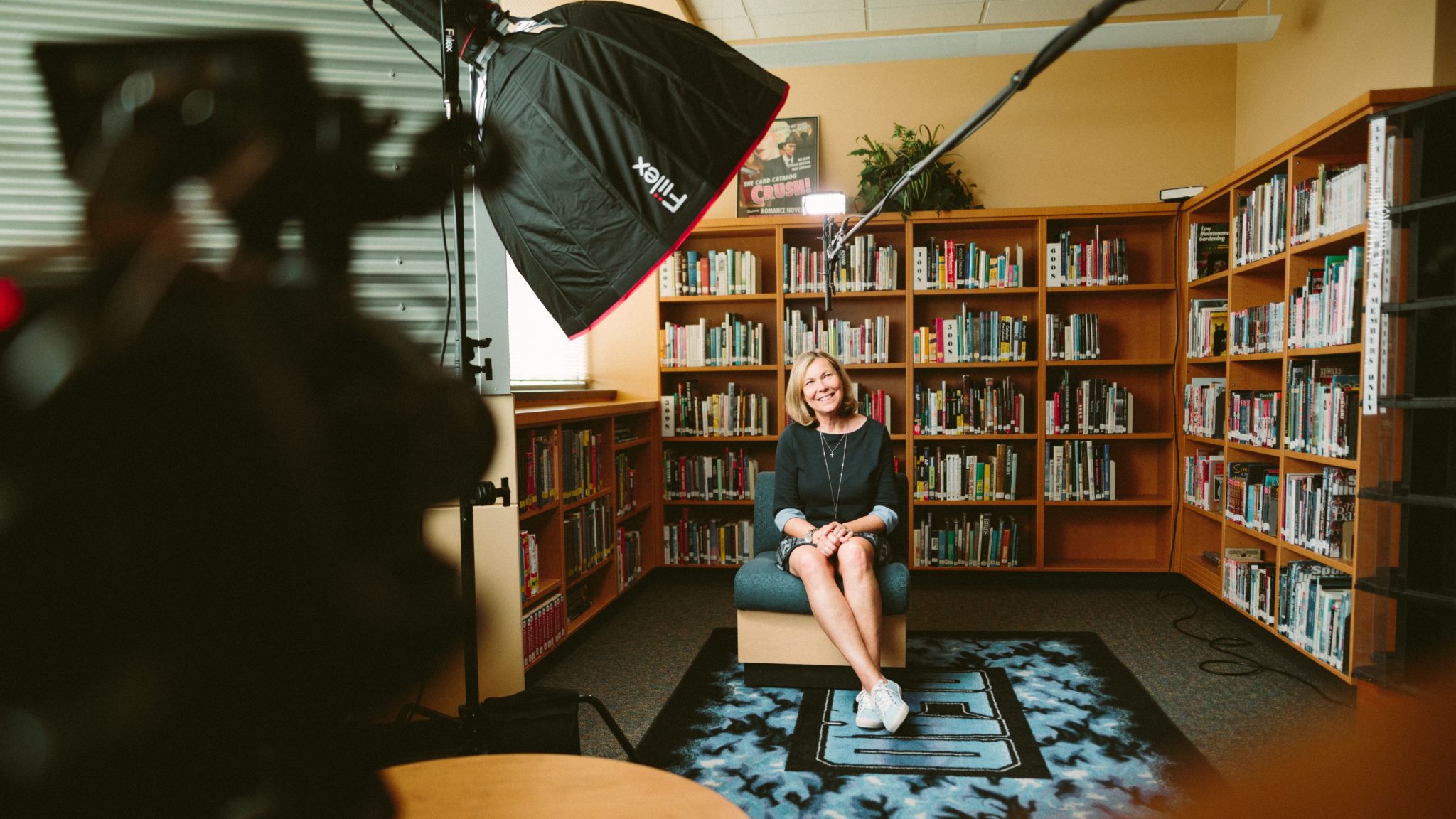 Here’s a compelling statistic: 69% of B2B marketers use case studies to help generate leads. Pair that with the 88% of video marketers reporting that video gives them a positive ROI, and the business opportunity for a case study video really comes into focus.
Here’s a compelling statistic: 69% of B2B marketers use case studies to help generate leads. Pair that with the 88% of video marketers reporting that video gives them a positive ROI, and the business opportunity for a case study video really comes into focus.
Here, we outline seven tips that have helped Karbo Com create videos that won over the minds of target audiences, (and the hearts of judges and award committees!).
Most recently our client, Penguin Computing, came to us to help promote the company’s involvement in Director Ang Lee’s blockbuster film Gemini Man in advance of the film’s world premiere. Karbo Com harnessed the power of a video case study to highlight the company’s solution and convey how it was essential to making the film a reality.
Managing the entire video production process from conception to completion, the Karbo team developed a project plan and led the initiative smoothly, ahead of schedule and within the scope of the budget. The final videos were strategically released on social media, online, and at Penguin Computing’s biggest trade show event of the year. In recognition of the Gemini Man case study videos, Karbo Communications was awarded a Gold 2020 Hermes Creative Awards and won the 2020 Silver Telly Award.
1. Define Your Target Audience
The foundation for any case study starts with clearly defining who that target audience is and what drives their decision making. Honing your message to cater to a clearly defined audience will propel your case study video to have the greatest impact possible.
Don’t know where to start? Ask your comms team to assist in developing personas to outline actionable insights about your target audience. Communications teams are experts at understanding where your message should land and how to get it to stick.
2. Precisely Outline What You Want to Accomplish
The next step in the development process is crystalizing your communication goals and objectives. Begin by understanding what compels your target audience to take action by answering the following questions:
- How do we outperform competitors in our market?
- What are the key messages that will most clearly convey our benefits?
- What do we want the audience to know, feel, and do after having watched the video?
- What key elements of our messaging lend themselves well to video?
Once you have a firm grasp of what your goal is and what your objectives are, gather assets such as white papers, customer testimonials, and statistics to help illustrate your points. Having a specific goal and clearly articulated objectives allows you to evaluate materials you can use to support your “case,” and eliminate what’s extraneous. With those materials in hand, your communications team can begin crafting questions that guide your subjects to tell a compelling story.
3. Ask Leading Questions To Craft Your Story
When spearheading the development of a case study video, you’ll need to coax the right answers from sources. Guide your subjects to help tell your story by developing questions that cut to the chase.
Ask questions that provoke your subjects elaborate on the following aspects of the project:
- The situation
- The problem
- The solution
- The outcome
Keep in mind that questions should always remain open-ended to stimulate interview subjects to expound on their thoughts. Follow that protocol and you may find yourself with some additional soundbites you didn’t even know you wanted!
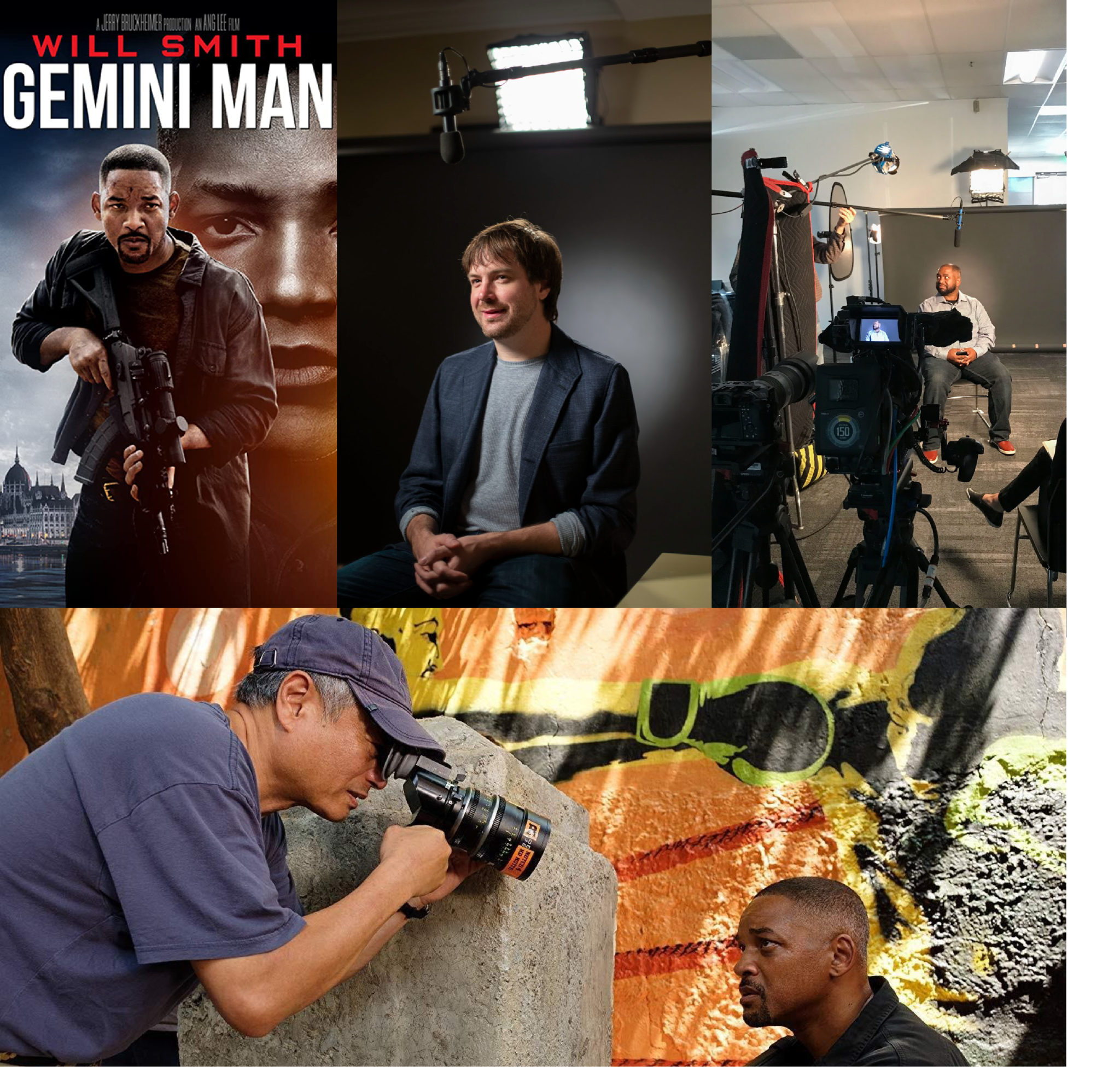
Behind the scenes at Karbo Com’s video for Penguin Computing showcasing how our client’s technology enabled director Ang Lee to bring Gemini Man to life.
4. Storyboard & Script the Narrative
A storyboard is a visual representation of a film sequence and breaks down the video’s elements into individual panels. Storyboarding your case study video will allow you to clearly establish the flow of the narrative and visualize how shots will flow and work together. It’s important to keep your visual brand identity in mind throughout the process to keep the video’s look and feel consistent with your brand. Ensure you have complete internal alignment on language, tone, and visuals before starting on the storyboard. The last thing you want is to discover the need to pivot halfway through production, wasting both time and money.
In the script, clearly articulate the opportunity, the solution, and the positive outcome. Support those key components with exciting and engaging visuals that illustrate, give color, and provide visual context to the story told by your interview subjects. Substantiate your successes by including data points in the script that highlight the impact your solution provided.
Lastly, include a “call to action” in your case study that drives your target audience to engage with your brand or your product. Remember, the greater goal of your case study video is to support marketing efforts, ultimately contributing to your bottom line.
5. Project Management is Critical
Assign a project manager to lead the planning process and handle day-to-day coordination to streamline production. Their role will be crucial in developing a production schedule and anticipating any roadblocks that could hinder progress. There are many moving parts from scheduling interviews and securing b-roll, to managing budget, location and props. It only takes one broken link in the chain to disrupt the entire production. Avoid that unnecessary headache by setting a realistic production schedule, emphasize production design and experienced direction, and secure buy-in from key stakeholders.
For the case study we orchestrated for Penguin Computing, the Karbo Com team assumed the role of project manager, setting the project budget, developing the storyboard and scripts, hiring a production team, and creating a launch plan that was ultimately executed and measured. Organizing all those components under one management umbrella allowed for a seamless production.
6. Keep It Brief
Video length matters! In fact, there’s a significant drop in viewer retention for videos longer than 2 minutes. Of course, length will vary depending on the content and the platform you are publishing to, but keep in mind that less is often more.
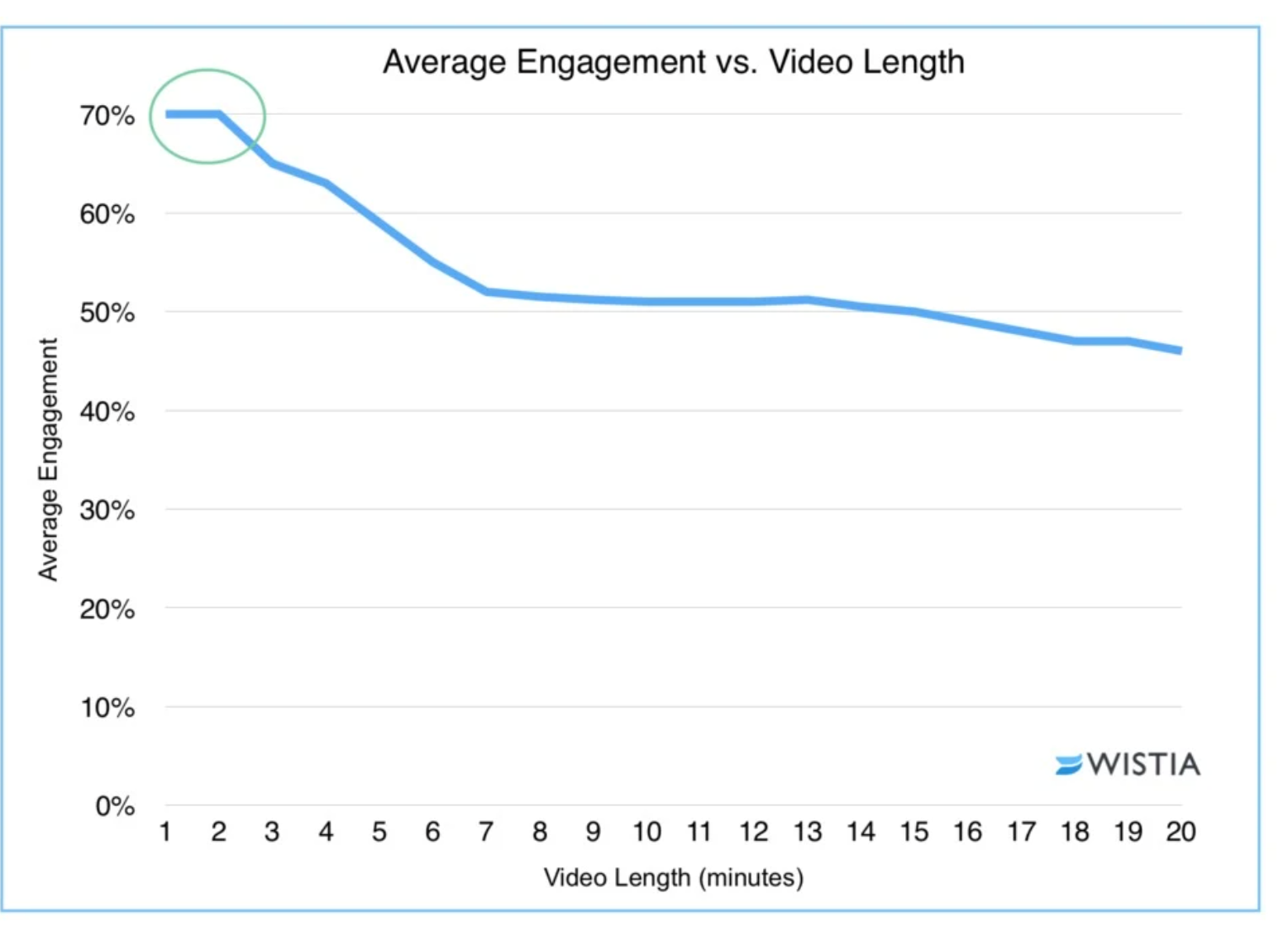
Average engagement vs. video length courtesy of Wistia
The best practice is to create cuts of varied length to best suit your website and social platforms. We’ve aggregated the optimal lengths per platform:
- Instagram — 30 seconds or less
- LinkedIn — 30 seconds to 5 minutes
- Facebook — 2 minutes or less
- Twitter — 20 to 45 seconds
- YouTube — 2 minutes or less
- Website — 5 to 10 minutes
For Penguin Computing, we developed a number of videos at varying lengths — allowing us to optimize each video for the specific platform it was published on and maximize engagement.
7. Launch Strategy
You’ve just finished your video. How do you decide when, where and how you’ll use it in your marketing efforts? There are a couple of ways you can boost visibility right off the bat:
- Use company social accounts to promote the launch (you can even create a specific hashtag)
- Optimize the video content for SEO by ensuring an SEO-friendly headline and appropriate meta descriptions and tags
- Encourage internal teams and relevant contacts to share and engage with the case study from their own social accounts
To drive further visibility, work with your PR team to gauge where, when, and how content like a video case study should be promoted. Leverage your PR team’s expansive network of relationships with reporters, analysts, and influencers to get your message in front of the right people at the right time.
Thinking about creating your own case study video? Get in touch with us and see how we can work to develop a video that will help you achieve your goals.
How To Create Unbeatable Brand Positioning That Moves Markets | 5 Tips from Karbo Com’s CEO Julie Karbo
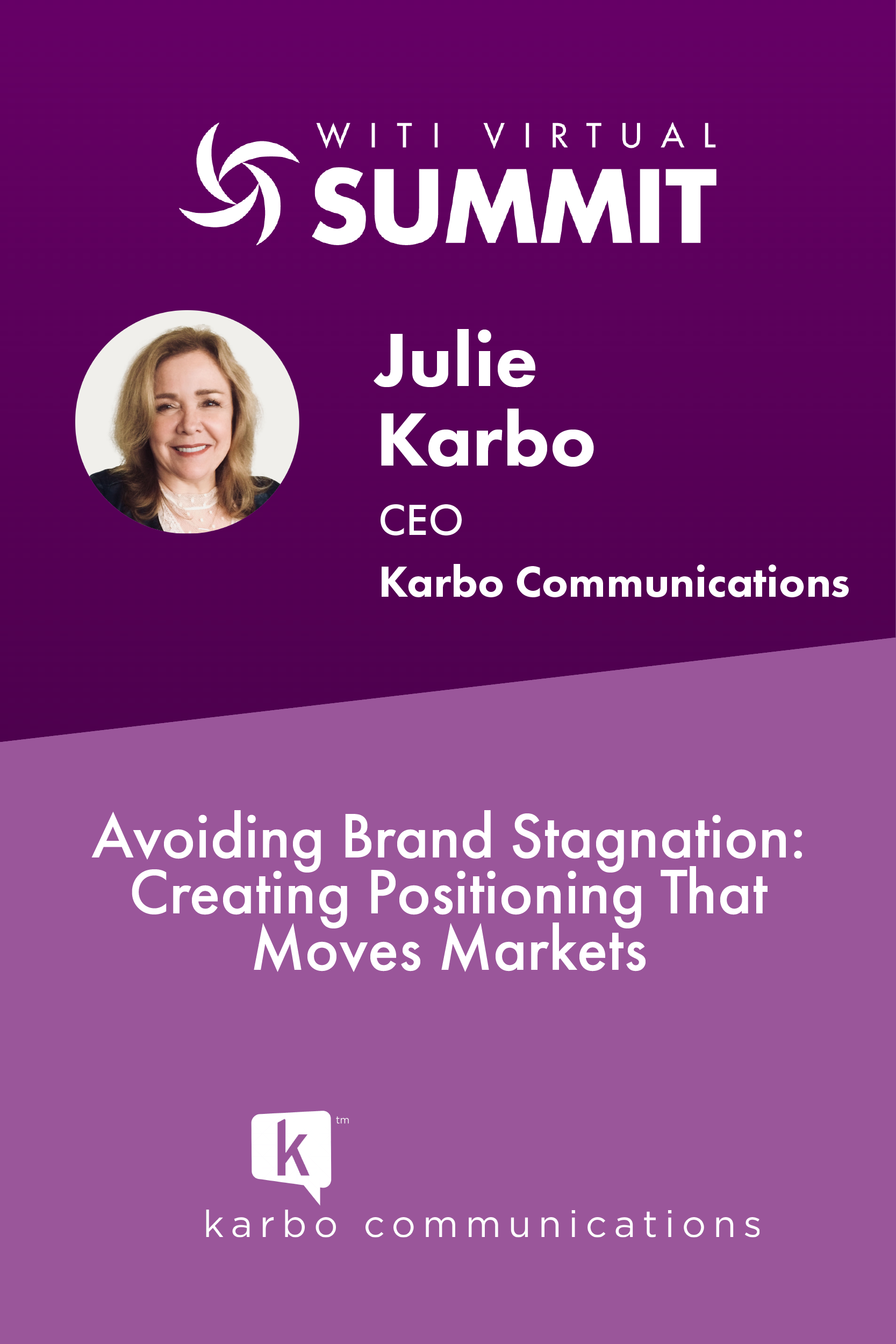
Last week, our CEO Julie Karbo led a Coaching Circle at the 2020 Women in Technology International Virtual Summit. A marketing expert who has helped thousands of craft successful brand narratives, Julie shared pages from her playbook on how to successfully move markets.
Branding & Positioning: Why It’s Important
Why is branding important? If you’ve got a better product it will sell itself, right? If only it was that easy. The streets of Silicon Valley are littered with failed companies that had great products, but didn’t tell their story in a way that moved hearts, minds and wallets. We’ve all seen examples of messaging that fails to accurately communicate a company’s value, differentiation and vision.
Branding exercises lay the foundation of a company’s communications with customers, partners, investors or any other entity that has a stake in what they do. The branding exercise itself is complex, time consuming and rigorous. It requires a commitment from the CEO to participate wholly and she or he must mandate the same from other members of the C-Suite. It’s critical that there be a commitment to unflinching honesty and self evaluation, with an exercise leader that asks the right questions, keeps the process productive, moving forward and free of arrogance and power plays. Those are just table stakes. Then comes the hard part.
Nailing Your Message
Branding is never a one-meeting-and-you’re done proposition. It takes a great deal of internal and external research, the ability to audit key audiences, collaboration across the highest levels of the organization, and a willingness to test its efficacy. Without this commitment companies can fail to craft the right narrative. It’s not as rare as you think. According to Forbes, only 1 in 4 corporate brands is perceived as different from their competitors.
Effective positioning:
- Speaks to the needs and motivations of key stakeholders
- Demonstrates strong, specific differentiation
- Includes compelling language that is tied to current trends
- Accurately describes the company’s mission, vision and products/services
- Drives results
Know What You Need to Know
Where does it all begin? With the customer. Do you have robust persona(s) of your target customer(s)? What are their demographics? What do they read? How do they make product purchase decisions? What do they do in their spare time? What keeps them up at night? What’s causing and alleviating their pain and what’s not?
That’s just the tip of the iceberg. A quality persona profile reflects the prism by which your customer judges you. Many executives believe it’s based solely on their product features. This is partially true, but remember your solution isn’t simply your technology platform and product, it includes the quality of your management team, what reporters, influencers, partners, your support teams and the competition say about you and more. At Karbo Com we call it the Whole Product Prism.
“Executing the branding exercise flawlessly is one of the most important things you will do as a company. Devoting resources is important. But just as critical is making a commitment to truth, introspection and collaboration.”
Getting Branding & Positioning Right
Once we have our foundational research done, we begin to craft the narrative. At Karbo Com, we manage the overarching process, and will craft the first draft of straw man messaging according to three categories: market, technology/product and company. These straw man messages are discussed with the whole team and once these narratives are finalized they are tested with customers, partners and other influencers.
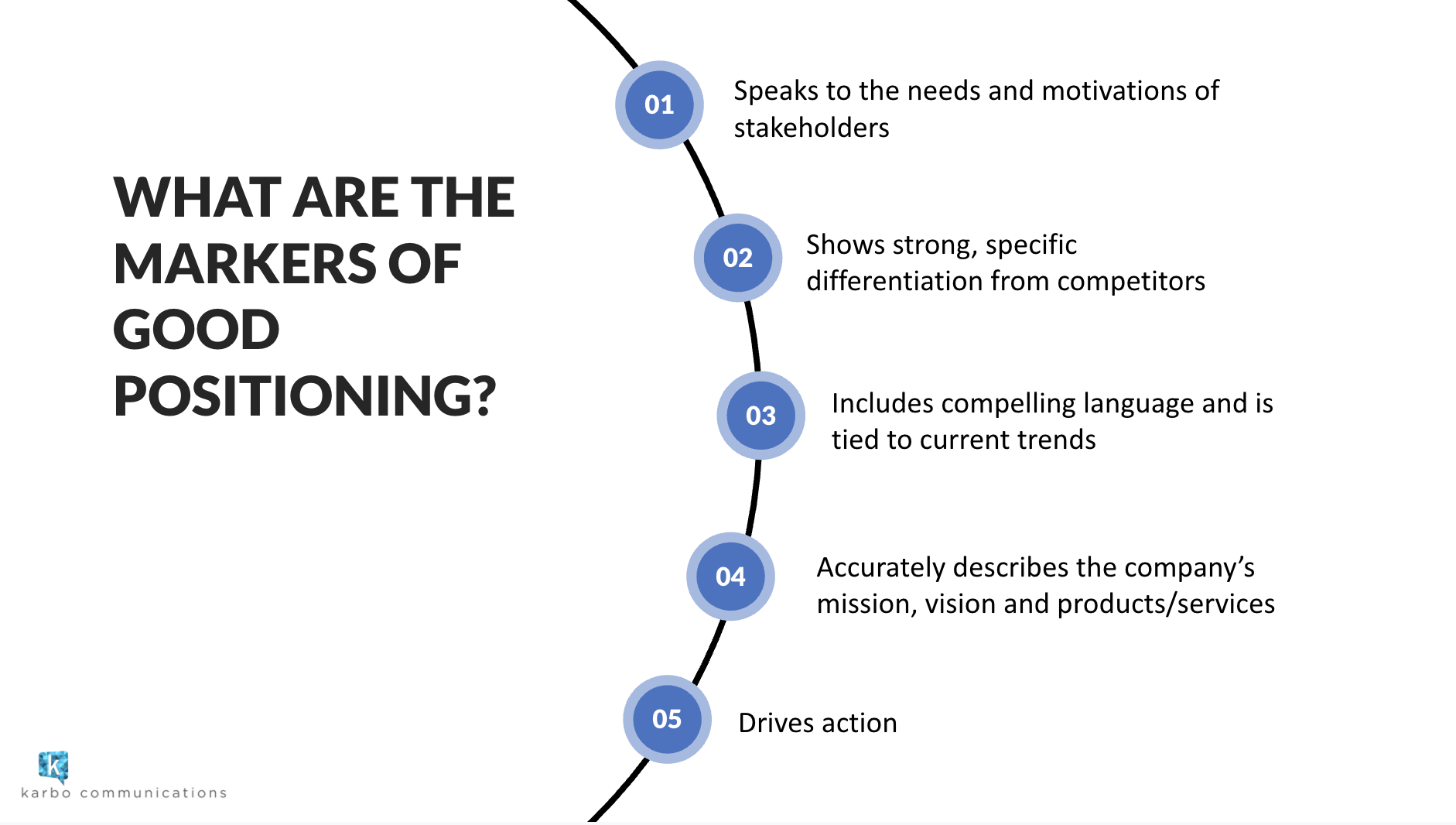
A slide from Julie’s presentation outlining a few markers of good positioning.
How Do We Know It’s Working?
Measuring branding efficacy requires accountability, and accountability starts with the identification of qualitative and quantifiable KPIs. Karbo Com then uses analytic platforms to help determine success metrics. One size doesn’t fit all. Measurement is a function of the unique needs of each company. Key components can include sales leads, sentiment, competitive response, influencer concept tests, share of voice and a host of other metrics.
Executing the branding exercise flawlessly is one of the most important things you will do as a company. Devoting resources is important. But just as critical is making a commitment to truth, introspection and collaboration. Finally, you have to pledge loyalty to your narrative — to tell your unique story in a way that moves markets.
Looking to up-level your branding & positioning? Contact us.
In The Know | Jonathan Sadow, CGO, Scoop Technologies

How should companies approach growth to achieve results during times of challenge? Karbo Com joined Co-Founder and Chief Growth Officer Jonathan Sadow at Scoop Technologies, the largest carpooling solution in the country, to learn more about the strategies they are deploying to successfully navigate uncertainty in one of the hardest-hit industries impacted by COVID-19: transportation.
In a Zoom-facilitated “In the Know” discussion, Jonathan shared his thoughts on what business growth tactics work during a market slump, how Scoop has leveraged virtual events to bolster their marketing efforts, and the future of commuting after the immediate impacts of COVID-19.
Can you give us a brief intro on Scoop and what inspired you and your brother to start the company?
Today, Scoop is the largest carpooling network in the country. We partner with enterprises to offer commute solutions to their employees and create more meaningful and empowering ways to get to work.
My brother Rob, Scoop’s co-founder and CEO, and I first started thinking about Scoop in the spring of 2014. We commuted (via carpool!) nearly 250 miles per week to get back and forth to high school — so this was a problem we were very familiar with personally. When we moved to the Bay Area later in life, commuting became a big part of our lives again. I started commuting three hours down to Mountain View and back. A few years later, Rob moved here from New York. Overnight, the commute became an important factor in his daily life again.
Around the same time, I was building a market research tool while working at Google. I happened to run a survey asking people what their top frustrations were in their personal lives and their professional lives. The only thing that was in the top five of both survey responses? “Traffic.” A light bulb went off for us. We thought, “Oh, this is the same pain that we’ve felt since we were kids and that we feel now. Why hasn’t anybody done anything about it? What are the solutions?”
We started to systematically break down the problem and eventually believed that carpooling and scalable, shared commuting were going to be the answers to solve the commuting problem at scale.

Scoop Technologies’ carpooling app seeks make the daily commute a more enjoyable and reliable experience for the working professional.
Tell us about your journey from co-founder to CGO — what led you and the company to identify the need for this role?
It’s a great question. My CGO title is new as of only a couple of months ago. From the very beginning of Scoop until just earlier this year, I was co-founder and chief product officer. In Scoop’s earliest days, it was me and our founding engineer and my brother. Product Management was at the center of what I did, but my job was often much more dynamic than that. But, it didn’t feel like my job title really mattered all that much.
As we grew, we came to realize that titles can come with a lot of baggage. Along the way as we were building out the Marketing team, or the Analytics team, or this year, when I took on the Operations team, we discovered that there were preconceived notions of what it meant for a Chief Product Officer to lead those functions. And those preconceptions could alter perception around what a team’s mandate was. In practice, the role I was playing was actually leading a collection of functions that all have one goal: growth.
And so there was a real authenticity to the team saying, “Hey, we’re happy to be working with you, and we love the mandate of all these teams coming together, but it feels strange for a Marketplace or Operations team or Analytics team to roll into Product, right?” I realized that maybe that wasn’t the best encapsulation of what we’re trying to do. It was with that in mind that we decided that it was time to transition my title from Chief Product Officer to Chief Growth Officer, which encompasses everything from Marketing to Analytics to Operations to UX and Product.
How does a CGO differ from or complement a CMO?
In my eyes, a growth organization tends to be more dynamic—it has a couple of different functions coming together. A growth organization might flex in its focus area and its makeup over time. We may shift from being more product-oriented for a while to more operationally-oriented, depending on what the company needs to drive growth.
When I think about the goal of a CMO, it’s really about what’s at the center of the bullseye: establishing the brand positioning of the company, and the way that you want to go to market and communicate who you are. Essentially, it’s the way that you think about putting your product out there. And growth certainly might be a part – or even a big part – of that picture. But for a CGO, growth stays at the center of the bullseye, and then you invest against these different levers and functions to drive that mandate.
It’s nuanced, but the idea is that for a CGO, marketing is a piece of the growth pie. Whereas from a CMO’s perspective, marketing is the north star, and growth might be a particular output of that marketing-oriented effort.
“While we understandably want to be data-oriented, intuition gets a bad rap. One of my favorite quotes is, ‘Intuition is your brain processing everything you know faster than you can realize.'”
Solving growth challenges requires rigorous experimentation. How do you approach experimentation at Scoop? What does that process look like?
At Scoop, we talk more about testing than experimentation. I’m a little bit of a nerd on this because when I worked on research on surveys at Google, I became obsessed with what it means to have statistical significance and how to actually generate actionable, quantitative insights. I think that we mess this up a lot in this industry. We may be trying to run an A/B test and use sophisticated tooling, but we often don’t have the right sample size, or we don’t have the ability to actually do that significance testing or analysis.
One of the smartest pieces of advice I’ve heard on this was from the engineering lead from the team I was on at Google, Brett Slatkin. He said, “Look, you’re not going to be able to get data fast enough to move as quickly as you need to successfully experiment. What you need to do is test and iterate. Iterative testing is way more valuable. Because by the time you run your A/B test experiment, you could have just built iteration number two, and gotten it wrong the first time.” Because of this advice, Scoop has been much more iteration oriented. I think many, many early teams would be more well-served to think about testing capabilities and instead of pure experimentation.
Another perspective of mine is that while we understandably want to be data-oriented, intuition gets a bad rap. One of my favorite quotes is, “Intuition is your brain processing everything you know faster than you can realize.” If you think about a great athlete, they’re not making calculated decisions on every shot. They study that on the macro level, and then they rely on instincts and physical mechanics to get them where they need to be. And that’s something that drives our decision making and experimentation as well.
Now when we launch features at Scoop, we all put numbers on a board and say, “I think it’s going to be X percent, Y percent, and Z percent,” and see how close we are. If our intuition is good, that helps us drive toward an iterative approach, as opposed to always A/B testing everything. I think growth is often associated with high capacity, complicated A/B testing. And I’m not sure that always serves the purpose of what we’re trying to accomplish to build a great product.
How do you evaluate specific growth opportunities and determine whether or not they’re worth pursuing?
I’m a big believer that growth is really about valuing the ROI on user insight. Great product development is about solving a user problem or bringing user value to bear. And so you’ve done the user research and you’ve looked at the data. You’ve found where you believe you have gaps, where you’re coming up short on solving the problem, or where you can amplify the existing solution that you’ve created.
Real growth opportunities come from where you can get the most output, relative to the least input, while solving one of those user problems. And so it comes back to evaluating those challenges, evaluating what it would mean to solve them and understanding and being critical about the incremental cost and return on investment of a better solution.
For us, it’s quite systematic. Some of the best advice that I’ve gotten is that the most valuable thing you can do to create growth is improve product/market fit. We often talk about product/market fit like it’s a binary thing we discover. But it’s really a moving target. There are layers of it, you get it and you lose it, you improve it and detract from it. And so oftentimes people don’t realize that the best thing they can do to grow is usually just to make their core product better to augment product/market fit.
Community building is a major aspect of Scoop’s business model and something that you put front and center in marketing materials. How does the focus on relationship building give you an advantage over some of your competitors in this space?
A lot of it has to do with how we see our business model and the problem that we’re solving, which is fairly distinct from companies that might at first blush like competitors, like the Ubers and the Lyfts and other folks in mobility. Yes, they’re all in the mobility space, but the problem we’re trying to solve is one of a very different composition. We don’t employ any of our drivers. We’re not building a short-distance solution–we’re here to solve the commute’s tough challenges. Everything we do is truly peer-to-peer, and longer distances reflect most commute behavior.
We’re asking people to give of themselves to make the marketplace work in a way that’s different than when you’re paying or employing one side of the marketplace. Trust becomes just that much more important. Scoop needed to create a community of peer-to-peer trust that’s quite different from what other marketplace companies aim to establish.
A lot of our community focus has to do with us learning over time what really matters to people in the car. One of the major transition points for Scoop was in 2017. We did some branding and positioning work and what we found was that people cited that the community itself was actually the most compelling reason they used Scoop and enjoyed their experience in the car. They liked meeting people, they like turning time that was normally solitary and frustrating into something that was social or informative or networking oriented. At first, community was a requirement to be able to create that necessary layer of trust. But over time, it became something Scoop continued to foster because community is what people found value in.
“Be very careful about pivots or the pressure to pivot. It’s very easy when you’re making that assessment to say, ‘We need to change our product to adapt – or even to take advantage. Can we do things to support the coronavirus environment?’ That’s typically a luxury of big companies and companies with a lot of excess cash.”
Let’s discuss business growth in an economic downturn — how has Scoop’s growth strategy shifted in light of the pandemic? Which new or modified growth strategies have you deployed?
The first piece of understanding growth in this environment is to understand the reality of the situation. It’s been a very challenging time for Scoop. There’s a lot of uncertainty facing the mobility business. We had to think about what our economic position was to give ourselves a chance to navigate through this and that was hard. It was painful for the team and even more so for the folks who we had to let go of. But it was the first step of saying, “Okay, let’s acknowledge that this is a changing environment.”
Getting focused became incredibly important. In times when the economy is rich and you’re growing and there’s not all this pressure, it’s easy to get bloated or unfocused, or just take on that extra project. When you have slimmer resources, you need to think more critically about how you invest your cash and what you work on. The number one priority is getting the company to focus back on the one or two things that are most important.
The second priority is assessing and making bets on what we think is changing the world. I think that’s the hardest part. Saying, “What are our beliefs around how the world is going to change? How confident are we? How much of this is going to change over time? And when are we ready to start putting a stake in the ground?” There’s still a lot of uncertainty, but we do know that people are starting to think about going back to the office and that there are very specific needs and opportunities facing the marketplace that we can solve. So part of it was looking to assess those, make that bet, and then drive our focus forward into that area—and then doubling down and doubling down again and saying, “Okay, let’s presume we know where to go here.”
The final piece is to be very careful about pivots or the pressure to pivot. It’s very easy when you’re making that assessment to say, “We need to change our product to adapt – or even to take advantage. Can we do things to support the coronavirus environment?” That’s typically a luxury of big companies and companies with a lot of excess cash. For startups, it’s important to remember that if you have a mission you are trying to accomplish, you have to be careful not to derail the long term vision. Sometimes it is important to turn that corner, but sometimes that can be a big distraction.
At the end of the day, our job is figuring out how to help Scoop’s customers balance the needs of their community, which is going to be a safe, reliable, and convenient way to get back to work, with what they as companies need, which is a solution that’s flexible and scalable. Those are the real pieces of the puzzle we’re putting together from a growth perspective.
“Sometimes growth means creating your own signal. It’s not just going and meeting customers where they are, it’s telling them where they need to be.”
Let’s circle back to your important point about the pandemic forcing focus. How does Scoop separate the signal from the noise?
In today’s world, it’s not easy. For us, the greatest signal comes from the mouths of our customers. We talk to every single customer. You need to go out and ask questions, figure out how the market is feeling. And where you’re not finding answers, those are often the areas that your customers need answers from you.
At Scoop, we realized early on that many of our customers didn’t have answers for how their employees would commute and come back to work, and that this was a hole we could fill for them. In this case, we could have been looking for signal all day long, but we were actually the ones who needed to create that signal—to do the research, to share the data, to build the plan.
And that’s a really important thing for companies to realize. Sometimes growth means creating your own signal. It’s not just going and meeting customers where they are, it’s telling them where they need to be. To that end, data is the other piece. The best way to filter out signal from noise is by looking at numbers. Do a survey. How many people say they’re going to come back? There is a lot of nuance here. If you want to figure out how to chart that path out of uncertainty, trust data.
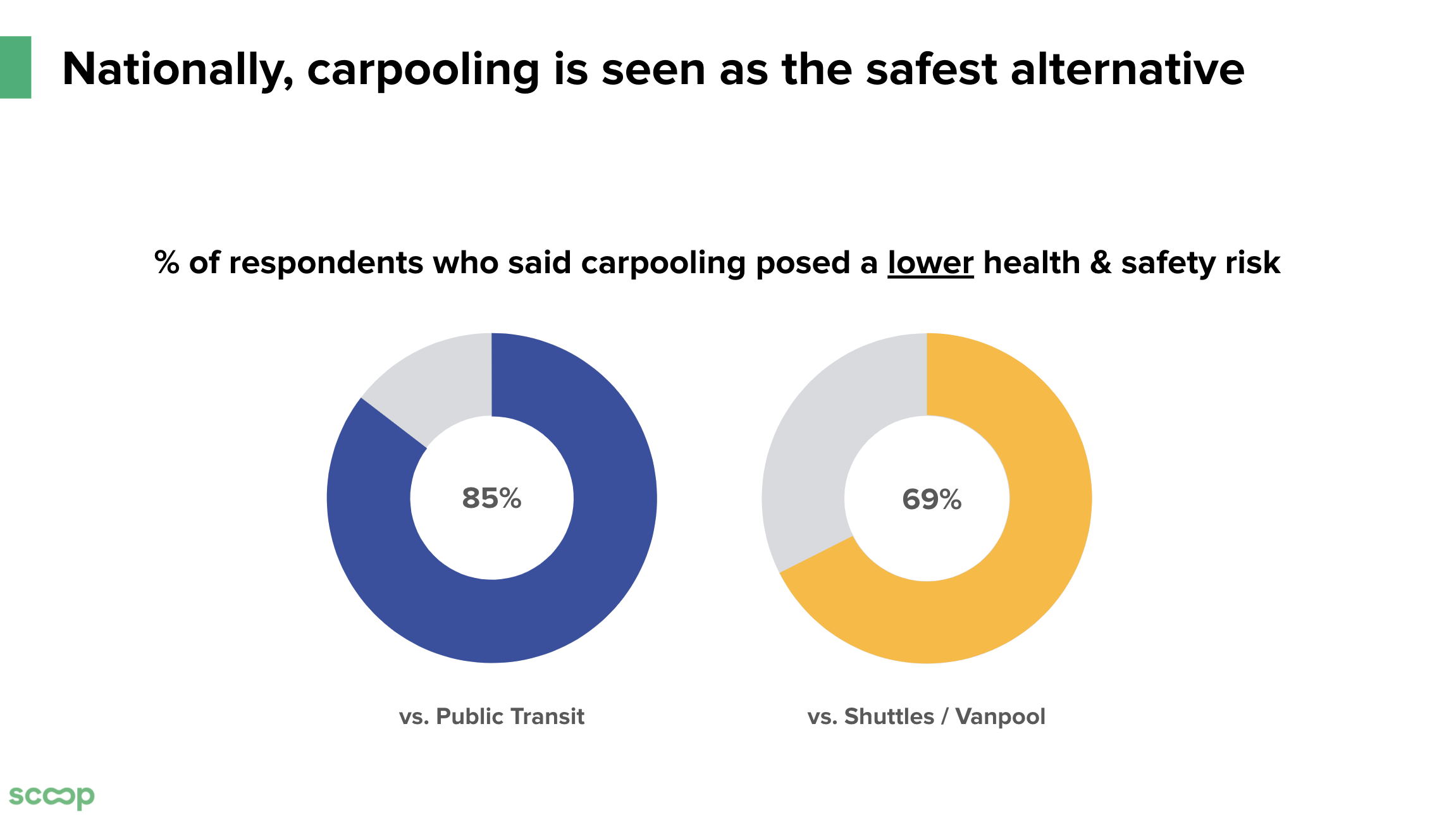
A recent survey conducted by Scoop Technologies revealed the majority of commuters feel carpooling is safer than public transit. These survey results were released in a virtual webinar to key stakeholders — which has been a productive strategy for Scoop.
The sharing economy has been massively affected by COVID-19, however some analysts are saying the pandemic has opened the door to the “revival of the sharing economy’s original ideals of community cooperation and peer-to-peer trust.” Are you counting on that analysis unfolding?
We’ve always thought of ourselves as the truest form of what sharing is. Sharing is when you and I are giving something to each other out of the desire to actually have each other experience what we have to offer one another. That dynamic changes when you add an employment, compensation, or service orientation. Our Scoop drivers don’t want to be ride-hailing drivers. This is something they do because they want to make a few dollars to cover gas and share an experience with co-workers or friends or neighbors.
When I think about how coronavirus may affect the sharing economy, I am not sure that it’s going to change the fabric of sharing so much as it’s just going to put pressure on business models that don’t invest in both sides of the sharing equation. When your sharing is based on one part of your marketplace being compensated and the other part of your marketplace getting value, you have to compensate well enough and return that value on the other side of the equation. When the economics of a business gets squeezed, providing enough compensation for value gets hard.
Of course, coronavirus has increased the need for health and safety trust. If you and I commute to the same company, and we both have the same symptom checking requirements and temperature checking requirements and mask requirements, I’m going to feel more comfortable getting into a car with you than I am with someone who may be operating under different circumstances.
At the end of the day, what we know is that people still have to commute, they still have to get to the office, and so when we think about sharing there, we know that the tightness of community is going to provide value.
With community being at the core of your business, do you foresee autonomous vehicles playing a role in Scoop’s evolving model?
Autonomous as a technology is really compelling. But there are a lot of layers. For instance, let’s think about this from an environmental perspective. I think we can agree that autonomous vehicles need to be electric. If we had autonomous fleets of gasoline-powered vehicles, we’d be in serious trouble because they’d be causing the same emission problems that current vehicles do.
I also believe that autonomous vehicles will need to be shared. Let’s consider a full concept autonomous car: I’m sitting in the backseat, I’m watching Netflix or I’m working, and it’s great. Well, all of a sudden the demand for being in the car has increased tremendously and you’ve actually driven everyone to be in their own personal vehicle. Traffic and congestion have increased. That’s a disaster, right? That’s the worst possible outcome of good technology.
If those autonomous vehicles are shared—well that’s a different story. Hypothetically, if Scoop could put you and someone else in a car and you don’t have to drive, you can spend that time together and improve the sharing experience. No matter the technology, we’re going to continue to be the experts in how we make sure that you and I can share that space in a way that is safe and meaningful to us.
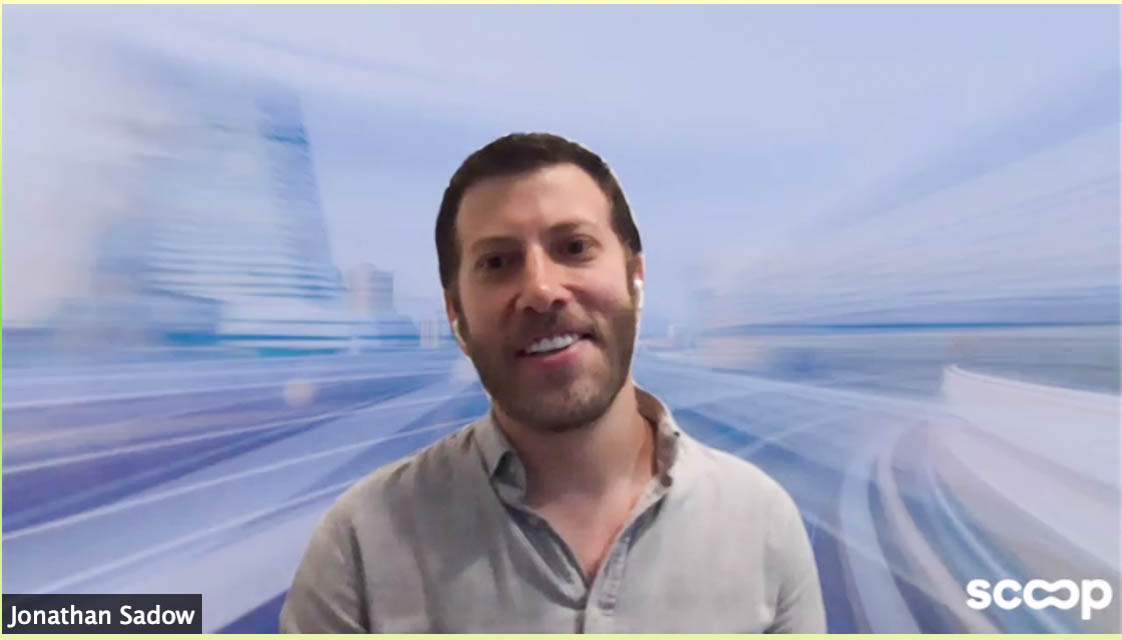
Jonathan Sadow in discussion with Karbo Com over Zoom on strategies that can lead to growth during the economic downturn.
You recently co-led a webinar on analyzing and addressing commuter sentiment in the COVID-19 world. How do events like those support your greater growth strategy?
These virtual events have been great for us, frankly. Right now, there’s so much learning going on and webinars are just a really high touch way of distributing information en masse. And it only takes an hour of someone’s time to attend. I don’t have to fly somewhere or go to a conference.
The transition from live events to webinars has allowed Scoop to communicate at scale with our customers, prospective customers, and governments, and get our information out there without all the overhead. They’ve been really successful and I expect them to continue. Do I think that they will replace in-person meetings? Not entirely. Do I think that they create the same type of personal connection? Not necessarily. You do lose something in the formality of the webinars, but it’s been a great opportunity for us to get hundreds of people to events where they can hear what we’re thinking about and share their own ideas as well.
What advice do you have to companies that are in the midst of transitioning to virtual events?
Three things stand out to me. The first is that if your goal is to teach someone about what’s happening in the marketplace, you have to remember that you probably know more than you realize you do relative to your audience. Your job is to be the expert on the topic. That’s why you’re the one hosting the webinar. And sometimes the simple things are what’s really valuable.
Number two is more tactical. And that is encouraging your team to amplify webinars within their networks to build awareness. In the past, we were always a little careful about that. But the reality is that people want the information we can provide. And everybody has different networks and so it’s really okay to teach your team how to be an amplification of your core strategy.
The third is, these things are hard to do. It takes a lot of time to put together a good presentation. And if you’re not putting together something great, it’s not going to be worth your time. Know that you’re going to need to look at the deck and look at the materials and tell a good story and work through the narrative.
You currently partner with some of the biggest names in tech — LinkedIn, Rakuten, and Samsung just to name a few — how is the carpooling industry dealing with the growing trend of tech giants offering permanent work from home options for employees?
We’re paying a lot of attention to how people are feeling about working from home. This goes back to our earlier discussion around what it means to stay focused and to use data to determine signal from noise. Our research shows that nearly three-quarters of people would prefer to be working predominantly in the office or in a hybrid environment in the long term. So in a post-corona environment, most people want to be spending at least a good portion, if not the majority, of their time in the office.
What people want is flexibility—that’s what we’re seeing in our surveys. I think that’s the thing that the tech companies are going to wrap their arms around. It’s easy to transition to work from home when everyone’s working from home. But what happens when half the team comes back to the office? What happens when new people join your company? If you haven’t ever met them in person, you don’t have any of those instinctive signals around who they are and how they operate. Those things are going to create challenges where connectivity in the office is critical.
We saw in our research that while 70% feel connected to their co-workers when they’re going into the office, only 30% of work from home employees feel connected. That’s going to create long-term challenges around retention and engagement and productivity in the workforce.
What we’re going to find is that technology companies will have the ability to be dynamic and flexible. However, there are a lot of people around the country, including some in tech, who already need to be at the workplace, or are going to want to return as soon as they can. And when they do, they’re going to need a way to get to work. If all of a sudden I work from home three days a week, do I still need to own a car? Or what if I don’t own a car? How do I get to the office on days four and five? Our job is to be that flexible, scalable solution to help employers offer commute solutions that enable their employees to feel empowered to choose what works best for individual circumstances.
This interview has been edited and condensed for clarity
Want more “In The Know” expert insights? Learn how the tech industry is navigating the mounting uncertainty of COVID-19 in Karbo Com’s interview with Fortune’s Digital Editor Andrew Nusca.
In The Know | Andrew Nusca, Fortune Digital Editor

Fortune Digital Editor, Andrew Nusca | Photo by Virgil Bastos
Businesses are beginning to reopen, some dealmaking has resumed, and new coronavirus cases are declining, but studies show that consumer confidence remains low. Economists who were initially optimistic about a “V-shaped” recovery, are now warning that elevated levels of unemployment are likely to continue into the coming years. Karbo Com joined Fortune’s Andrew Nusca to learn more about how the tech industry is navigating the mounting uncertainty and what he’s hearing from Fortune 500 CEOs.
As Fortune’s Digital Editor and co-chair of the publication’s Brainstorm Tech conference, Andrew has his finger on the pulse of the tech industry’s response to the evolving pandemic. In a Zoom-facilitated “In the Know” discussion, Andrew shared insider insight into the state of venture capital and the new VC mindset, the critical role of media relations, where we go from here, and what we can learn from the companies that are leading the way.
Some have applauded the leadership of the tech industry during this uncertain time; Amazon and Instacart have been lauded as saviors for helping people self-isolate, and video conferencing services like Zoom have kept the remote workforce going. But others have voiced criticism, saying that the pandemic has revealed the limitations of even the world’s richest companies’ ability to respond and innovate in the face of the pandemic.
How would you characterize the tech industry’s current role in our society? Do you see the tech industry leading the way during this time?
You know, I don’t believe tech is a monolith, but I do see leadership within the industry. It’s interesting that year ago we were only talking about the backlash—the techlash. We even programmed a session at our Fortune Brainstorm Tech Conference that we hold every year in Aspen around this topic.
Fast forward to today: no one’s talking about a techlash. Everyone is completely attached to their technology right now: their video chats, and emails, and Slack. This is how we’re able to communicate during this period of social distancing.
I think tech companies are always trying to be at the forefront, but now they are really trying to get it right. The big companies are enjoying the fact that their products are needed more than ever and other companies are looking at this pandemic and thinking, “How can we apply our technology here?”
You mentioned Amazon being lauded for helping us stay at home, and by every extent they are doing that—but it’s very much in their interest. Amazon leapt up to number two on our Fortune 500 list this year, and that’s for 2019, it’s retroactive. It will be very interesting to see where they land in 2020. They’re just doing what they do best. And I think anyone who was perhaps a bad actor and caught up in the techlash is just happy that they are no longer in the spotlight.
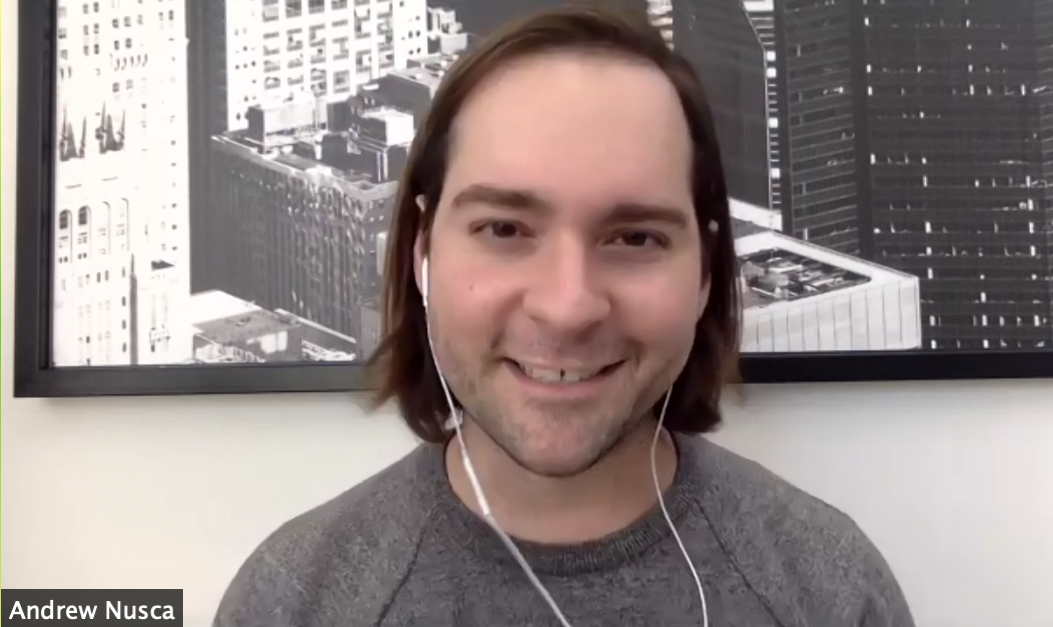
Andrew Nusca in discussion with Karbo Com over Zoom on the current state of the tech industry during COVID-19, and what lies ahead.
Which companies are emerging as the leaders? Who is setting the standard for how companies can successfully adapt?
Well, I think the question is who got a great hand in this deck so to speak, right? I saw a headline by another publisher saying that Amazon has hired as many people to handle the increased demand as work at the Ford Motor Company, which is a Fortune 10 company. So Amazon is doing extraordinary amounts in hiring and getting up to speed. But of course, we all desperately needed Amazon. So it’s just accelerating an existing strategy. Its direct competitors, who have been trying to compete on this basis are also doing really well. Walmart for virtually everything, Target, Best Buy for electronics. They’ve all been experimenting with using their retail stores as warehouses and this kind of moves them along.
So all of the retailers who had a great digital strategy are enjoying this, the ones that didn’t are very much going out of business. So it’s a haves and have nots in retail. Anybody who’s in the business of productivity, Microsoft, you mentioned Zoom at the top of this—and here we are using that technology right now. They are running to either get their clients set up with these technologies, expediting user adoption, or putting in more infrastructure.
Right before the world shut down, I was supposed to interview the Zoom CEO for a Fortune event. Of course we had to cancel the whole thing. But I know for a fact that since then, he’s been doing nothing but trying to put infrastructure in place and declining any further interviews, so he could spend his time there.
So, you know, I think there are just companies that got a great hand and were kind of on the ball and could take advantage of it. And the ones that weren’t, are either struggling to catch up or or unfortunately, going out of business because of the broader economic picture.
Which industries or segments appear to be picking up steam? Where are you seeing the biggest areas of opportunity?
One category that comes to mind that’s been doing very well, of course, is food delivery. We’re seeing a lot of action in that burgeoning space. There was a recent announcement that Uber wanted to buy Grubhub, which is Seamless, and that would consolidate a market. So here’s a market that’s overall growing—I guarantee you every one of those services is trying to figure out how to get more people bringing you your food—but then there’s consolidation because companies see an opportunity to move.
Which models of adaptation seem to be yielding the best results?
Look, over the last decade, large enterprises I’ve been talking about enterprise transformation, digital transformation. And it’s a cute word. It’s a lovely piece of jargon. Companies love jargon. But who’s actually been putting their money where their mouth is? I think that’s that’s really who’s been benefiting.
Most companies in the United States are dealing with a work from home situation. How many companies were actually on the ball? Meaning everybody had laptops, everybody had phones, everybody can access systems remotely, and they don’t have to be on-site to do so. How many companies actually put all of that in place so that remote work can be done. Naturally tech companies themselves are usually pretty good at this. But everybody else…results may vary.
Which companies are succeeding in communicating the right tone, message, and cadence of information during this time? What does successful brand communication look like right now?
It’s typically the companies that had been nailing it before, because of the nature of their leadership and company culture. So anybody from Salesforce to Delta Airlines, who has been doing a very good job in an otherwise horrible spot.
It’s all about communication. It’s all about being forward-looking, here’s how we’re treating this. Every business is going to have to manage down a terrible situation. So in many ways, that’s not the novelty. The question is just how well they communicate to their staff. Make sure that you’re taking care of employees the best you can with benefits and extended policies, if you do have to lay people off. Really, really taking care of people, even if you do have to shrink your business. I think that’s been very, very different. A lot of companies have sat back and gone “Well, it’s industry standard”. The truth is there’s nothing standard about this time right now. This is a once in a generation. So the companies that are really, really trying to take care of their folks, I think are standing out.

Companies like Delta and Salesforce are setting the standard for brand communication during the pandemic.
On the flip side, what early communications missteps have companies made that we all ought to be learning from?
Not thinking your employees are as smart as they are. I’ve seen so much executive communication as you can imagine, doing what I do, covering what Fortune covers. We’re paying very much attention to what every CEO is saying, and if you aren’t giving your employees the full picture, they’re reading it every day in the newspaper, hopefully on Fortune.com. They very much see where the puck is going, and I think it’s frustrating for a lot of rank and file employees to not have clarity and not hear from their leaders. No one’s asking them to predict the future, but they would like to know how bad things might really be. And of course, there are restrictions for public companies in that regard. But you know, I think most people just want a fair shake, you know, to be a partner at a difficult time.
What trends and movements have you observed as the tech industry responds?
The biggest tech companies are doing very well. Not only do they provide the services that we need at this time, but also they were doing well when we entered this. Startups with a good amount of funding are feeling good that they have a good amount of funding, while startups that don’t are very, very concerned that they’re running out of runway.
I think it’s very clear which kinds of companies or categories are going to benefit at this moment. Education companies are all of a sudden back in the forefront. We talked about them years ago, and the conversation, I don’t know, it went away. Not so sexy. And now it’s back in a big way because everybody’s stuck at home with their kids. And they didn’t exactly take jobs as full time teachers on the side.
There’s health, obviously. Telehealth is seeing a lot of movement, a lot of money is flowing into those areas. And like I said, enterprise tech productivity is continuing to gain momentum.

The first photo to ever be published on Instagram which was founded in 2010 following the Great Recession.
On the subject of startups, what are you seeing in terms of funding and how VC firms appear to be conducting business at this time?
There’s always activity. There’s not always money right away. But I think investors are willing to put down money on a company that they think is really good. Where you’re seeing the fall-off is with follow-on companies or companies chasing a hot sector that has been flooded with VCs. I think you see that kind of stuff dry up when there’s a downturn.
But look, we have to remember existing startups need more runway and more money because they can’t predict the future. So they’re going to be raising quietly behind the scenes. God knows at what valuations, but they’re going to be raising. Certainly new companies that don’t have a lot of funding or are looking for a little bit more, so that’s still ongoing.
Some of the world’s largest companies were founded in the downturn like General Electric, General Motors, IBM. And then in the last recession we saw Uber, WhatsApp, Instagram, Venmo. Those were all founded one or two years after the economic downturn of 2008 – 2009. So the good ideas are out there. And it’s kind of just a Darwinian moment, I would say.
Good ideas come in a downturn. That is a theory that I think most smart venture capitalists hold. The question is, which idea or company is the good one? We’re seeing a return to the fundamentals. You can’t be spraying money all over the valley as we’ve seen in the show Silicon Valley and other places where startup culture is lampooned.
You can’t do that in a downturn. You’ve really got to focus on the fundamentals, focus on making money, actual revenue, and not just a good idea that raises a billion dollars and just earns all that money with the hope that it’ll pivot its way into a business model. You can’t pull that stuff off in this environment. And so it’s not just a theory from an investing standpoint. People are looking for those moments, those diamonds in the rough. I think startups will be much more locked on what they need to focus on, which is of course music to an investor’s ears.
To switch gears, how has the relationship between companies and the media shifted? Has that relationship changed at all during this time, or are things business as usual?
Well, nothing’s ever business as usual in media. Right now there’s a great hollowing out of media companies right now as there was a decade ago. And I do find that it’s obviously harder to get an executive on the phone, because they don’t want to be seen as just talking to the press, they want to be seen as talking to their own employees or customers. So I think it’s a little bit harder to get them.
I also think that the nature of the conversation is changed. I was talking to a C suite executive at a pretty hot tech startup—I’m using that startup term loosely, they’re quite a large company but they’re privately held. And he was asking me how I thought his company could put its best foot forward in the pandemic in a way that’s beyond philanthropy. Because their business itself is doing just fine, but they want to help out during this crisis. That would have never been a question that I would have fielded previously. I think a lot of leaders are being introspective right now. And like I said, focused on what matters most.
What advice do you have for companies and executives that are looking to strengthen their relationship with the media right now?
In war-time and in peace-time, I emphasize the same thing: build a relationship. I’ll speak for my own publication. We are a business publication, we cover the Fortune 500 and Global 500 companies. We also cover all the startups that are going to become those companies in a few years. Uber got on our Fortune 500 for the first time this year—it’s been quite a ride. Now’s the time to invest in building relationships.
Of course, nobody wants to be talking about a product right now per se. Companies should avoid incessantly pushing out press releases. Instead, they want to be talking about customers and relationships and helping solve problems in the world. It’s a little bit tone deaf to be like, “check out our new product for the low low price.”
But now’s the time to open that dialogue with the media, if you haven’t already. Continue it if you already had it. It will really pay off down the line. What the press is interested in right now is just hearing what executives have to say. Everybody’s trying to compare notes. I’ve had executives ask me what other executives are telling me.
In this latest Fortune 500 issue that we just finished, I put together a package of 14 Fortune 500 CEOs who are just weighing in on how they’re thinking about reopening once the stay-at-home orders begin to subside. Everybody kind of wants to just compare notes.
As you speak to these CEOs, what trends are you picking up on? Where do you see the tech industry going from here?
Most executives acknowledge that they were hoping for a V-shaped recovery and maybe it’s gonna look a little more like a U or a W—or pick your letter of choice. Recovery is going to be gradual. The lingering effects of this are going to last a lot longer than we hope or expect.
And I couldn’t tell you which of those effects are going to last the longest. Every municipality is going to handle it differently, but it’s definitely not going to be business as usual. I think that most companies are trying to bring business back.
The thing that stuck with me the most was what Cory Berry, the new CEO of BestBuy told us recently. One of my colleagues interviewed her and she said, “It will come back, but it won’t come back in the same way and it will be very different.” And so we need to figure that out. If you were making business money in one way, how can you do it in another way? Even for media companies like mine who are getting record readership right now as everyone’s stuck at home and wondering what’s going on in the world—we’ve still got to figure out how to make money.
Everyone’s going to have to figure out—not to use such a well-worn cliche—the new normal and what that exactly is. And so I think that’s kind of the key takeaway for the future.
This interview has been edited and condensed for clarity
Want more “In The Know” expert insights? Learn what separates leaders in data analytics from the rest in Karbo Com’s interview with Nielsen lead data scientist Jake Dailey.
5 Tips For Effective Communication With Remote Teams

Life for most people has drastically changed over the last two months. Social distancing has made working from home mandatory in most cities. How companies approach managing teams outside the office in a time of crisis can be a challenging task.
So how can your team navigate this “new normal?” To get started, it’s crucial you align all internal communications and streamline how you correspond with your team.
Here are a couple key ways your company can begin establishing internal PR standards:
- Create and circulate a best practices document that helps educate team members on how to separate “work” from “home.” Encourage teams to create a space or office where they can focus solely on work. This is also important as they continue to make an impression on co-workers and others they video conference with.
- Encourage breaks. Sending out reminder emails or messages is a meaningful way to remind your team members that your organization respects their work-life balance. Even though your team may be cooped up inside, they should take some time to stretch, walk around by themselves, or just take a couple moments to clear their mind.
- Reach out to people. Encourage your staff to check-in with each other often by giving them the tools to chat. Talking with colleagues over the phone or through video chat can be a great way to catch up. Messaging apps like Slack and G-Chat are also great ways for team members to get that desk chatter that would normally occur in an office setting. It will help your team members feel less isolated, and give them a chance to open up.
- Plan fun events with your team via Zoom. Almost everything work and non-work related is being done through conference calling apps. Try things like a pajama staff meeting, a virtual cocktail hour, or just a quick check-in before starting a meeting to see how everyone is doing.
- Lead by example. Brief members of the management team on the internal comms plan and get their input early. Management will have useful insight into which strategies may be most effective and their participation in internal PR efforts will help kick-start participation from among the broader staff.
Aligning internal communications early will give your team members the structure they need to be as productive and happy as possible. There is no knowing exactly how long work from home mandates will be in place, so establishing the correct internal process early will go a long way.
Creating Business as Usual in Unusual Times: 5 Communications Tips for Navigating COVID-19 Fallout
 Technology marketing is unlike any other. It demands a different way of thinking and rapid adaptability. Tech marketers, like Apple’s famous tagline, ‘think different’. In the past, tech’s expansive influence on the world granted us the ability to thrive, even in hard times. But we’ve moved from the Wild West to Westworld. While we crave normalcy, nothing may ever be the same.
Technology marketing is unlike any other. It demands a different way of thinking and rapid adaptability. Tech marketers, like Apple’s famous tagline, ‘think different’. In the past, tech’s expansive influence on the world granted us the ability to thrive, even in hard times. But we’ve moved from the Wild West to Westworld. While we crave normalcy, nothing may ever be the same.
How can brands and PR teams create an island of calm for employees, customers, partners and prospects when the environment around them is tumultuous? How can we help ensure that our relationships continue to work? Nimble PR and communications are a critical element of a company’s HR, marketing, sales and new business strategies and actions. Here are five communication tips to consider in these unprecedented times:
Be transparent
The current climate has affected many companies’ ability to operate at full capacity. If the pandemic has affected your team’s ability to deliver services or products, communicate with your customers and community immediately. Set expectations for delays while confirming your ongoing commitment to the quality of your relationship. Regular updates will likely buy you much needed patience.
Be responsive
With inquiries from the media, customers, and prospects alike, don’t leave anyone hanging. A quick acknowledgement of receipt to confirm that you’re working through requests can go a long way for brand sentiment.
Avoid the urge to overdo communication
Continuing marketing activities is a priority, but keep in mind that everyone is receiving communication from what feels like every vendor they’ve ever had contact with and a host of new ones. Many simply ask if there’s anything they can do to help. Limit your communications to what is necessary and focus on relevancy and targeted solutions over concerned platitudes.
Ensure your PR focus is nimble and reflects understanding
The news cycle will be heavily focused on global health for some time. This is to be expected for a once-in-a-hundred-years event. While different industries, including the media, adjust to what may be the new normal, their priorities and interests have shifted. The major announcement that you’ve been planning for months may not be able to be a top priority for reporters at the moment. Consult with your PR team on messaging — does your product have impact and new relevance for your customers and their customers? If so, recast your messaging for greater impact. If not, assess your timeline. Be realistic about releasing company news right now, and whether revisiting your timeline or new vehicles for these announcements makes more sense and means better results.
Be a resource
While your company news might not make the most sense for media right now, identify other ways your team can be a resource. For example, do you have insights or data that validate a market trend the media is seeing during these challenging times? Package them in a way that is clear and poignant.
As tech marketers, we’re used to adapting to and creating change. While we’re not driving this revolution as we have others, we can control the way we respond. We can help make sure our relationships continue to function and grow as we navigate this ‘new normal.’
In The Know | Jake Dailey, Nielsen Lead Data Scientist

Today’s most successful companies are data-driven and winning strategies are defined by a company’s ability to extract actionable insights from their data.
To learn more about what separates leaders in data analytics from the rest, Karbo Com joined Jake Dailey, Lead Data Scientist at Nielsen, at the company’s San Francisco office to discuss the challenges and opportunities.
Let’s hear a little bit about the work you do at Nielsen.
I’m a data scientist and I work primarily on our digital products. When people think of Nielsen, they tend to think about our TV business: the TV ratings. These ratings give advertisers, content producers, and TV networks a meeting ground where they can agree on how much to value an ad spot.
It’s the same on the digital side: web publishers have advertising space online and there are plenty of people willing to go buy online advertising. Nielsen provides these advertisers with verification that assures them that if they run a campaign on a certain website, that they will reach the people they were told they were going to reach, achieve the promised number of impressions, and that their money will be well spent.
Advertisers are asking questions like, “How do I know that the ad I’ve paid for is being seen by real people and not robots?” Or, “How do I know that our ad actually had an impact on my business?” The data that some publishers are designing now tries to address these questions.
It’s my job as a data scientist to design the measurement and to think about this from a statistical perspective. For example, what’s the best, most unbiased, objective way we can measure how people are viewing ads and what the population is doing when it comes to seeing advertising?
How have you seen successful companies approach data?
The most successful companies are really smart about how they quantify their performance. They understand what exactly it is that they need to measure impact. But then in order to inform that, you need to start by asking “what are we going to do with this information?” Once you start asking that question, then you can get very specific about what kind of data would allow your company to make decisions and think critically about strategy.
These successful companies are great at harnessing data to observe how they’re performing. The road to doing this can sometimes require a big tech change for companies, but once they have that in place it enables them to move so much faster because they can iterate rapidly and can think about how to adjust strategy on the fly based on the key metrics they’ve defined.

How can marketing teams use data to make better decisions?
Many marketing teams are trying to understand the relationship between consumer characteristics—maybe behavioral, like the websites they go to, or maybe demographic, like how old they are—and their actions. One way marketing teams can use data to make smarter business decisions is by employing machine learning and statistics to predict consumer behavior and analyze outcomes in their data.
What are some key questions marketers should be asking themselves about the data they’re collecting?
One key question is, ‘What are the gaps in what we can and what we can’t observe?’ That’s so important in digital advertising, but I think it’s still a big blind spot in the industry. If you haven’t appreciated where you might be missing information, then you’re likely to be led astray.
An example of this could be that you have a dataset that only covers a small subset of the people you’re actually interested in targeting, or it might be that you systematically have a hard time getting people to answer a survey.
How do you address those gaps at Nielsen?
At Nielsen, we have a representative panel that we’ve recruited from around the country so we can observe what behaviors look like within the population.
The challenge with online advertising is that many advertisers can only target or measure people that already go to specific sites, search specific things, or buy their products. If I’m trying to understand if my ad worked and I’m only able to target the people that were already going to buy my product, how do I know that my ad made a meaningful impact on that decision? After all, if I’m only able to target those people, there’s a good chance that they would have ended up there even if I didn’t advertise to them.
So it turns out to be very hard for advertisers and publishers to come up with good measures of success in an inexpensive, scalable, and unbiased way. At Nielsen, bringing objective sensibility to the picture is an important part of the role we play with advertisers and publishers.
What are some common pitfalls to avoid?
Imagine a venn diagram with three circles: statistics, computer science, and business. Smart data science happens at the intersection of all three. What can be challenging is if you’re in an organization that doesn’t have people with skill sets spanning those areas. Not having the right experts on board is a pitfall to avoid.
On one hand, we now have tools that make it easy to take your data and see what’s going on in it, which has made data science and analytics much more accessible to people who may be approaching the field for the first time. The real challenge here is often when you try to draw a conclusion based on something that you’ve observed. There are a lot of factors that you have to take into account—and a lot of uncertainty you have to be honest about.
Your dashboard may be telling you that your campaign grew by a certain amount from this day to the next day among a targeted group. And you like to hear that. You make some decisions around ad spend based on that observed growth. But if you’re not being totally honest with yourself about the uncertainties then that data may be misleading. For example, did the average number of people seeing your campaign each day actually grow based on your strategy or is this just a normal uptick that doesn’t indicate a long-term, material improvement? This is the kind of tough question that data scientists and statisticians aim to answer.
It often comes back to having the right talent onboard: people that understand computer science, statistics, business and can help span that gap between what should be measured and the conclusions that can be drawn from that data.

At Karbo Com, we often generate compelling data by conducting surveys. What advice do you have for companies who want to design their own survey?
It’s incredibly important to understand who will respond to your survey. If you choose to do an online survey, you’ve got to ask yourself, ‘Do we have a way to measure what kind of people are answering our survey in the first place?’ And you need to determine if aligns with the people you actually want to measure. You might only get a certain demographic of person that’s actually willing to take a survey, and that can be a big problem for the conclusions you draw
Next you need to ensure that people taking your survey will be able to answer your questions truthfully. When it comes to the responses, you want to be very careful not to pigeonhole people into multiple choice responses that aren’t appropriate for them, while still giving yourself a way to analyze the data.
Sometimes we’d rather have an open ended response to whatever question we have to really understand what’s going on in the respondent’s mind without putting words in their mouth–this helps surface hypotheses to test through more surveys or experiments. However, in opting for open ended questions we accept that their responses are much harder to analyze and draw conclusions from than the quantitative measures we can create from other question types.
Another important thing to consider is the effect that incentives can have on the quality of results. If you’re offering folks an incentive to take your survey, then it’s likely that a segment of those people are going to just blaze through and not really spend a lot of time on it. So you may need to find ways to account for that.
Think about how you can get people to slow down and actually read the question. Maybe there’s a way to limit how fast they’re moving through the survey. And when you’re reviewing the data, take note of how fast they completed the survey. If someone sped through it and answered “A” for every question, you’ll need to question the validity of that data.
This interview has been edited and condensed for clarity
Want more “In The Know” expert insights? Check out Karbo Com’s interview with entrepreneur and investor Jay Adelson.